Such an important problem deserves a comprehensive data-driven guide.
That’s why we’re bringing you 100+ statistics on crime in US schools.
High-profile incidents have only added fuel to the fire.

In 2020, schools closed their doors following COVID-19 lockdowns.
Classrooms and once-crowded hallways were empty, and the issue of school crime seemed to all but disappeared too.
Only it didn’t.
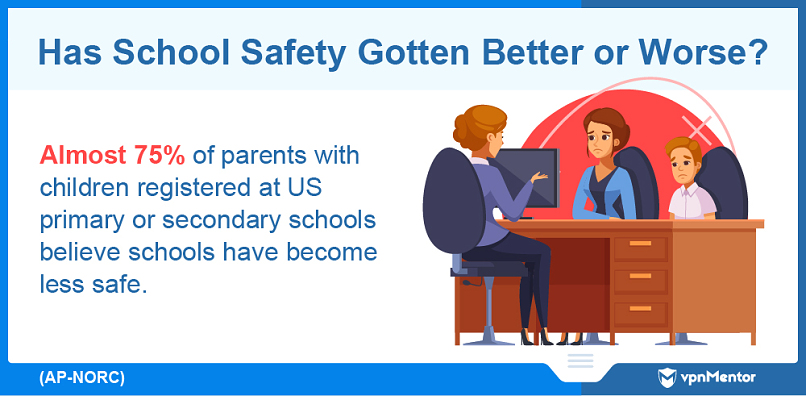
Plus, we’ve added a few tips to help minimize the risk of crime in US schools.
Crime in US Schools at a Glance
First, let’s familiarize ourselves with some general statistics.
How unsafe are schools?

Are school crime rates getting worse?
And what kind of crimes do students commit?
Have Schools Become Less Safe?

Most American parents believe schools are less safe now than they were 20 years ago.
Just 31% of parents are “very confident” in their child’s school’s response.
Recent incidents have thrust school shootings firmly into the public conscience.
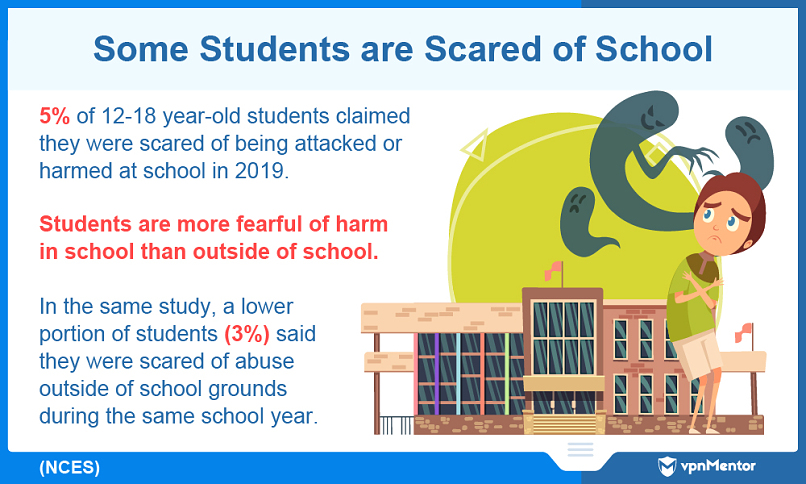
Students may feel more vulnerable away from the protection of their parents.
The Majority of Schools Report Crime
Crime is a part of everyday school life for many students.
Most schools experience criminal activities throughout the school year, with 80% of schools reporting incidents in 2017-18.
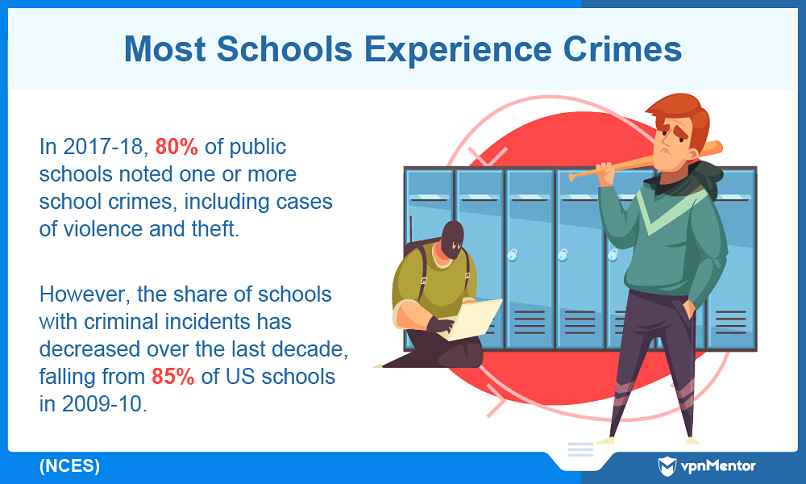
How Many Students Experience Crime in US Schools?
Nonfatal victimization includes the most common crimes, excluding counts of homicide.
In 1992, there were 181 total nonfatal victimizations at school per 1,000 12-18 year-old students.
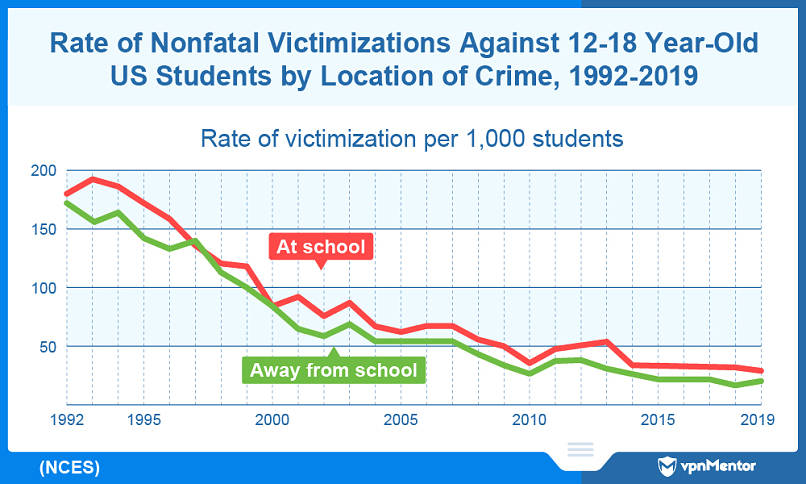
In 2019, that figure fell to 30.
The data indicates that US schools are indeed getting safer even if homicides are still making the national news.
Violent crimes can occur in bullying incidents and physical altercations.

There were nearly 20 violent crimes for every 1,000 US schoolchildren in 2017-18.
“Other” is the second most common category.
It’s worth noting that some of the most damaging incidents are often not recorded.
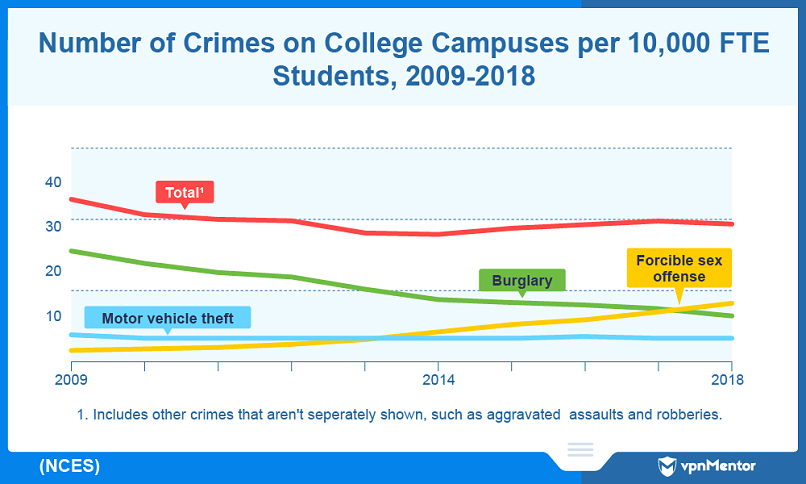
Everyday conflicts, such as verbal assaults and bullying, seem less impactful than isolated incidents.
Still, these occurrences can accumulate to cause significant torment to students.
How Often Do College Students Experience Crime?
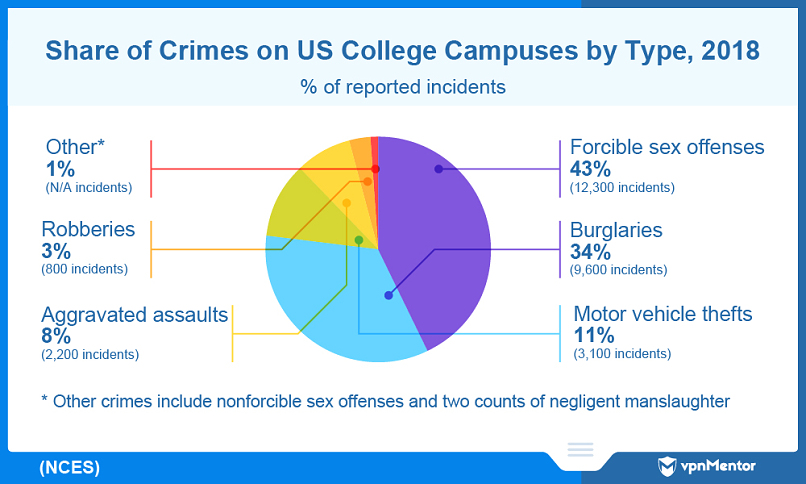
US colleges are required by law to collect and disseminate statistics covering crime rates on campus.
This means students know in advance and realtime how much crime occurs at every university.
Some 28,500 crimes were committed on college campuses around the US in 2018.
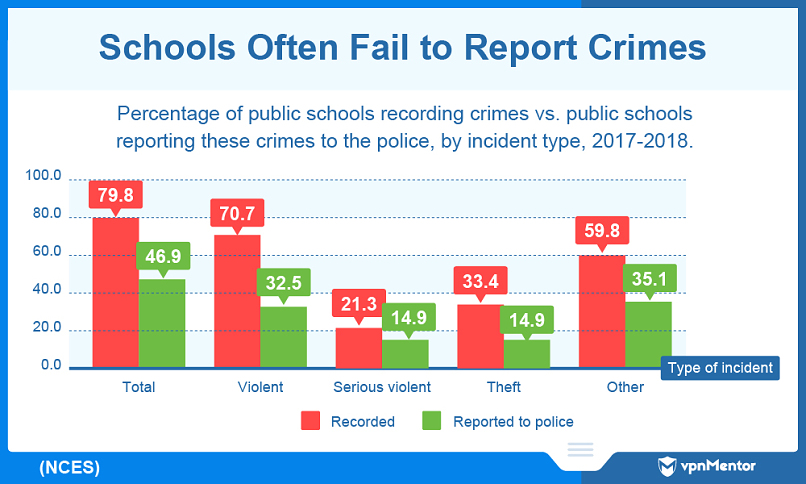
That figure represents a 16% decrease in the levels of on-campus crime compared to 2009.
The Most Common College Crimes
Some crimes are observed more than others on college campuses.
Students are especially vulnerable to forcible sex offenses.
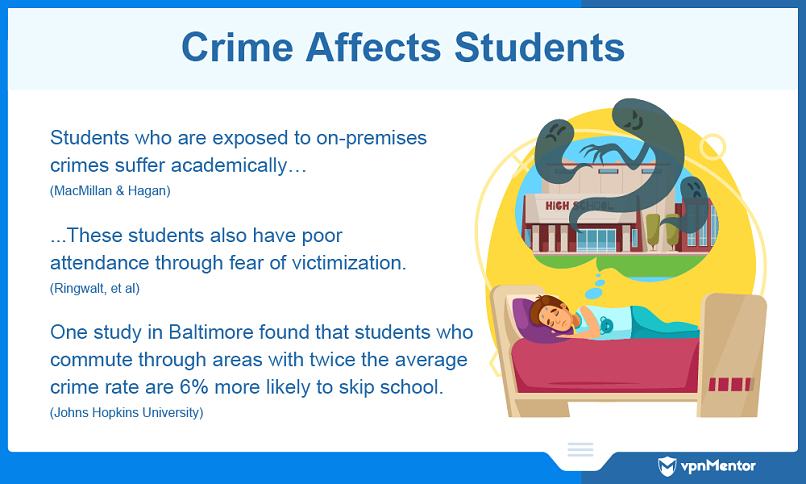
Burglary is the second most common campus crime; 34% of incidents fall into this category.
Which Crimes Arent Reported?
Another look at NCES data gives us a panoramic view of underreporting in US schools.
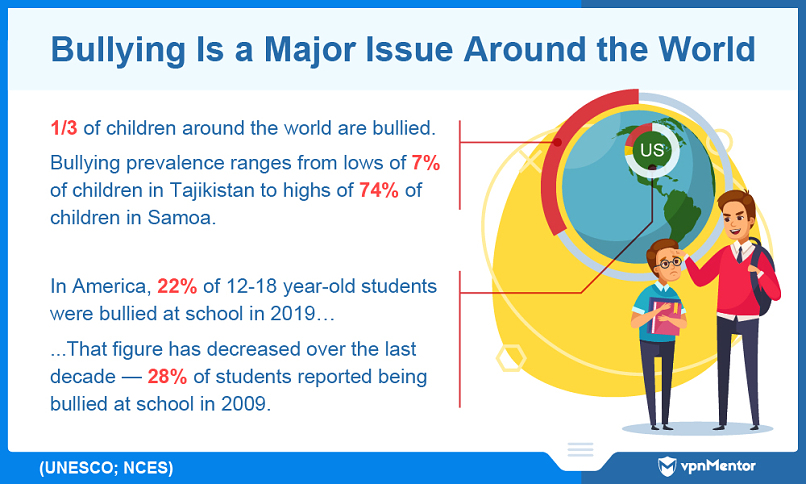
This is a big problem.
Violent crimes were among the most underreported types of crime.
But why exactly does underreporting happen in schools?
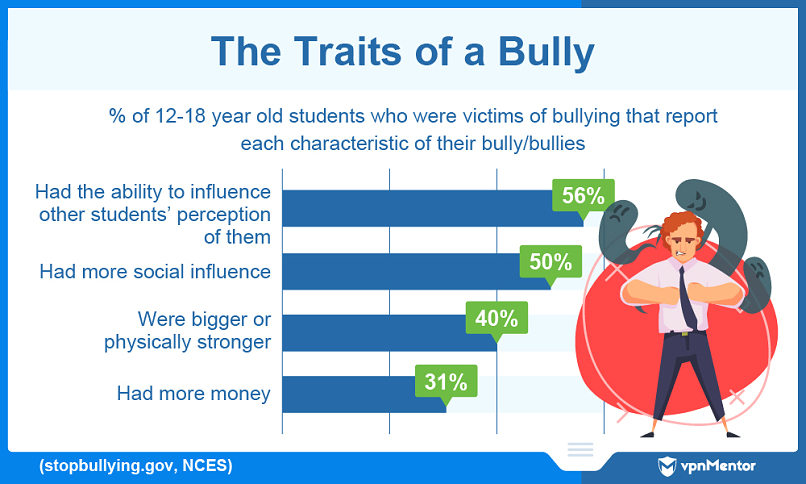
School leaders are under intense public scrutiny, particularly around issues such as school safety.
For many parents, inadequate safety measures are a far bigger concern than crime statistics or reported incidents.
The same can be said for students commuting through high-crime areas.

All 50 US States have anti-bullying legislation in place.
Generally, these laws define bullying and authorize school officials to step in when needed.
So, how do we define bullying?
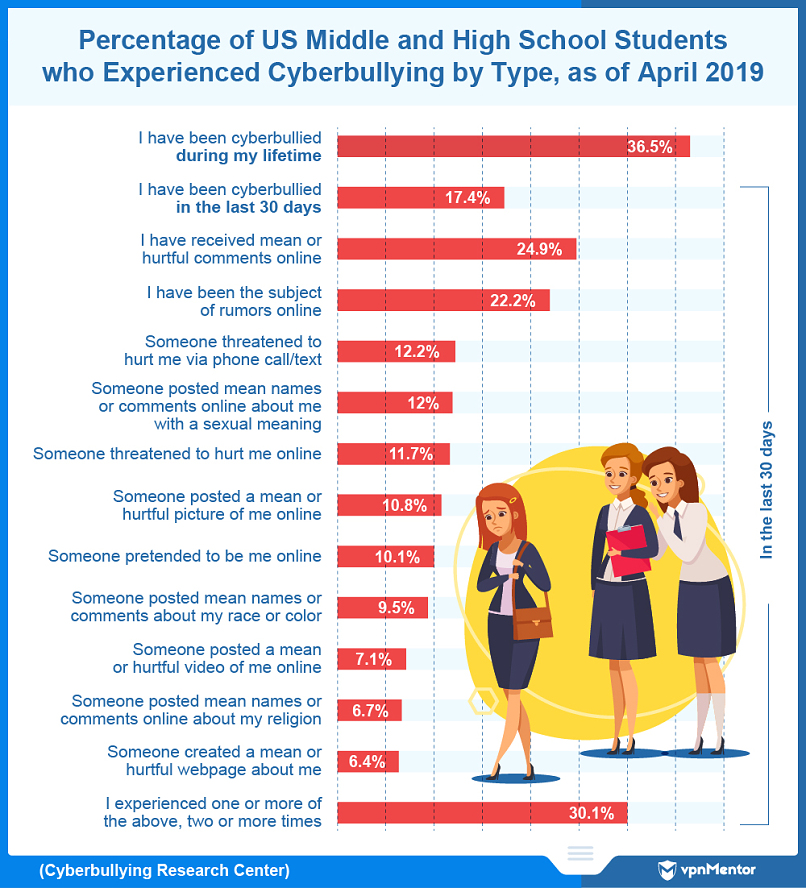
Bullying includes any action that seeks to harm, intimidate, or coerce a person seen as vulnerable.
Bullying can happen in person or online.
That’s because bullying happens so regularly and to such a damaging effect.

What Are the Traits of a Bully?
Bullies have a physical and social advantage over the students they target.
Time and again, bullies are strong and imposing.

They may even have an economic advantage.
Victims of bullying cite that their bullies have a higher social standing than them.
They’re more popular and can influence people around them.
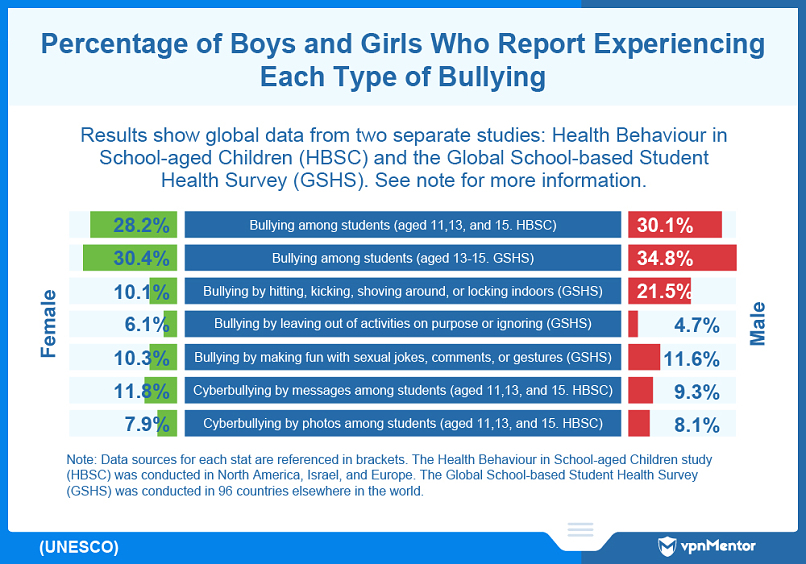
This explains why numerous students can be involved in bullying one individual.
Bullying Can Be Persistent
Bullying is not usually a one-off incident.
Bullies can target the same vulnerable individual persistently throughout their time at school.
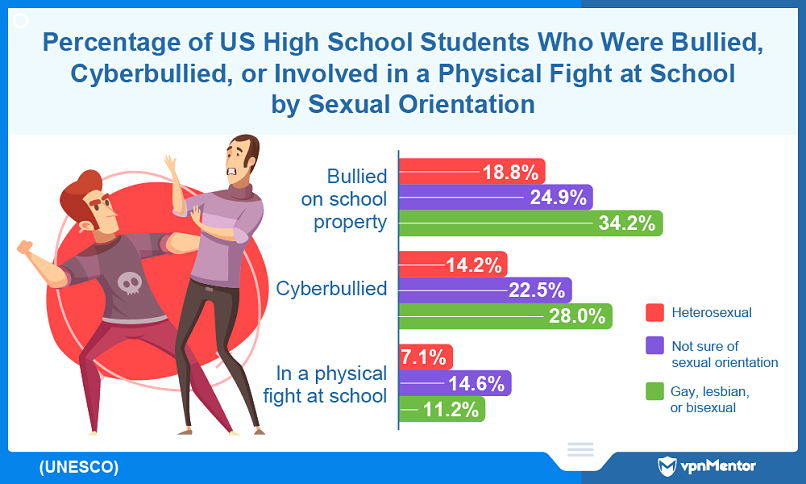
Bullies often continue to target victimized students on more than one occasion, amplifying the damaging effects of bullying.
Cyberbullying is a Major Issue
Cyberbullying is any form of bullying through online communications.
It may happen through email, SMS messaging, social media, and instant messaging.
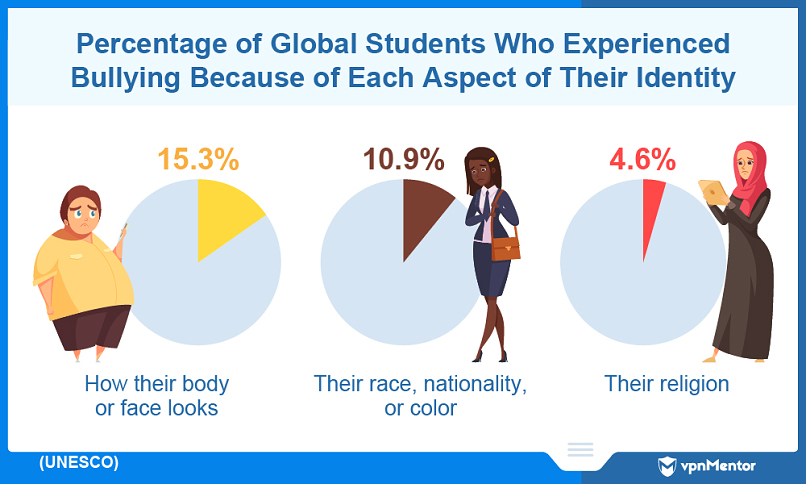
This jot down of bullying can be psychological torture for the victim.
Bullying Comes in Many Different Forms
Bullying can come in many different forms.
As mentioned, it can be verbal, physical, or even psychological.
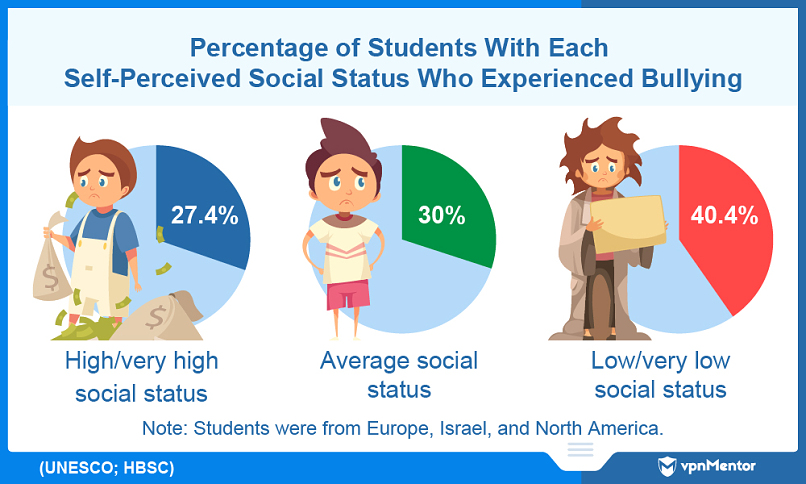
False rumors are the most common form of bullying experienced by US students.
Insults and name-calling are, unsurprisingly, another leading tactic.
Students can be pushed, spat on, coerced, or threatened by bullies.
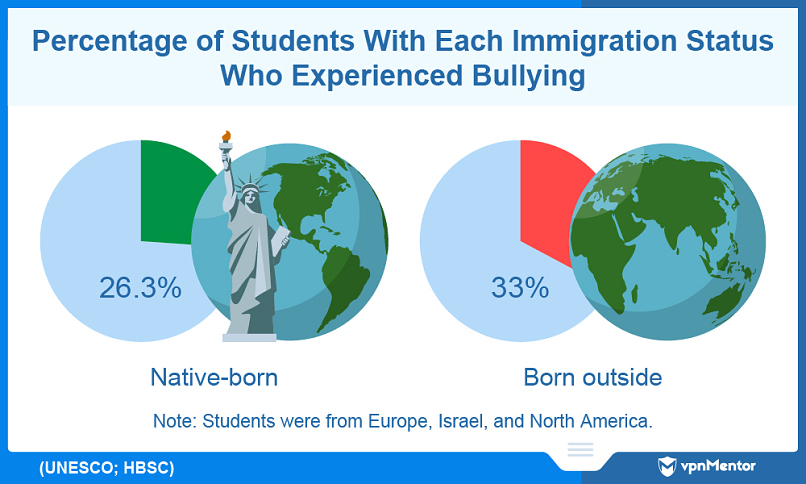
In some cases, a bully might break a student’s possessions.
Bullying can be psychological rather than physical, too.
Students who are purposefully left out of activities can feel lonely and excluded.
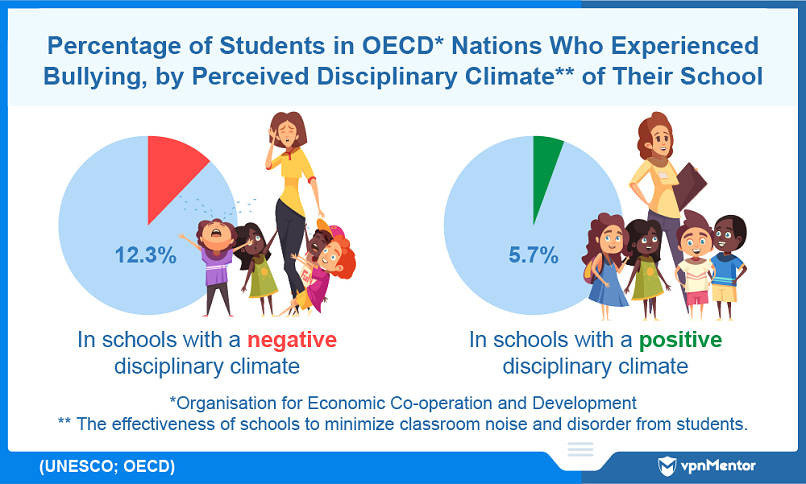
Characteristics of Bullied Students and Their Schools
What factors influence bullying rates throughout the US?
NCES data found that girls are bullied slightly more often than boys.
Bullying is more frequent in the lower year groups and at rural schools.
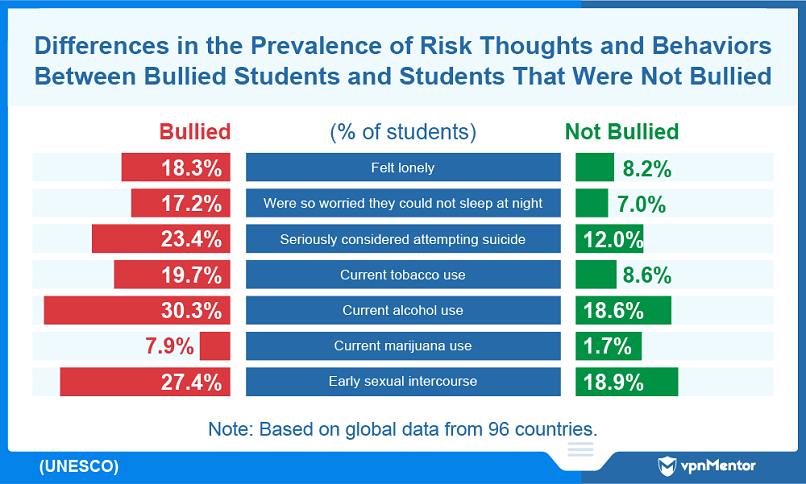
There is no real difference in bullying rates between public and private schools in the US.
Is School Bullying Sexist?
However, violence disproportionately affects boys.
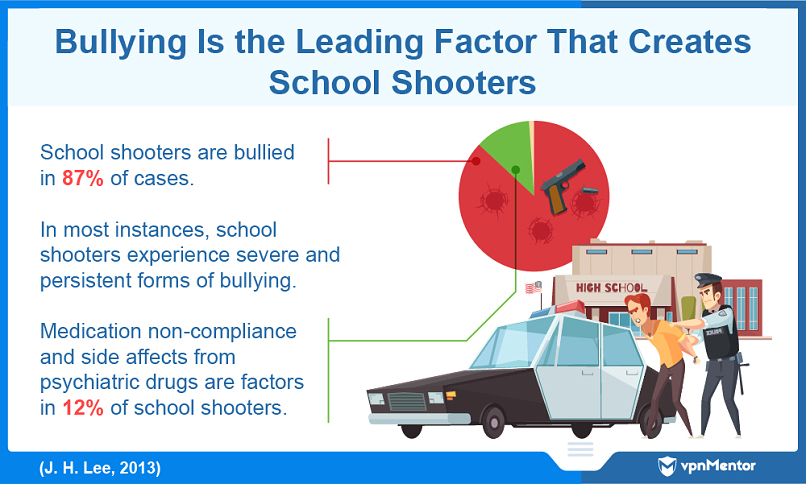
Girls are bullied more than boys in 23 countries throughout Europe and North America.
Overall, girls and boys are bullied at a similar rate across the world.
Global data also shows that boys are more likely to be physically bullied than girls.

This difference is even more pronounced in other nations.
Transgender students are 5 times more likely to be bullied.
Bullies will generally pick on students who look different from themselves and other students in the school.
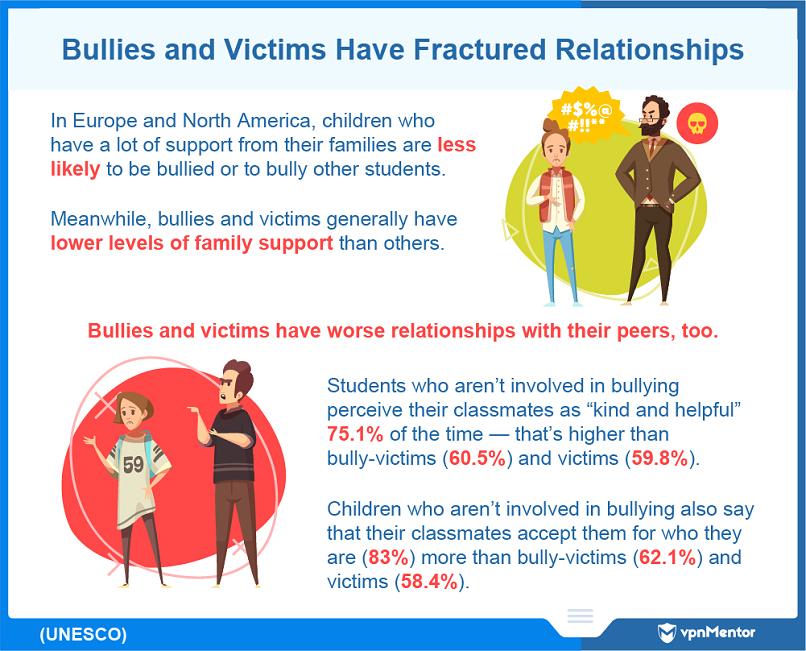
Students are often bullied because of the way their body or face looks.
The victim may be disabled, disfigured, or regarded as different in some other way by the bully.
Physical appearance is the number one reason students are bullied globally.
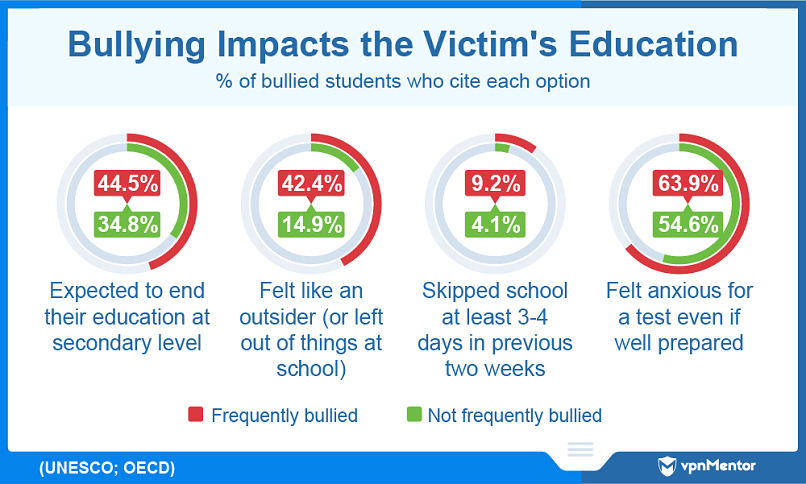
One-third of North American students are bullied based on their physical appearance (World Health Organization).
Students may also be bullied because of their race, nationality, or skin color.
This is the second most common motivation for bullying, cited by 10.9% of students.
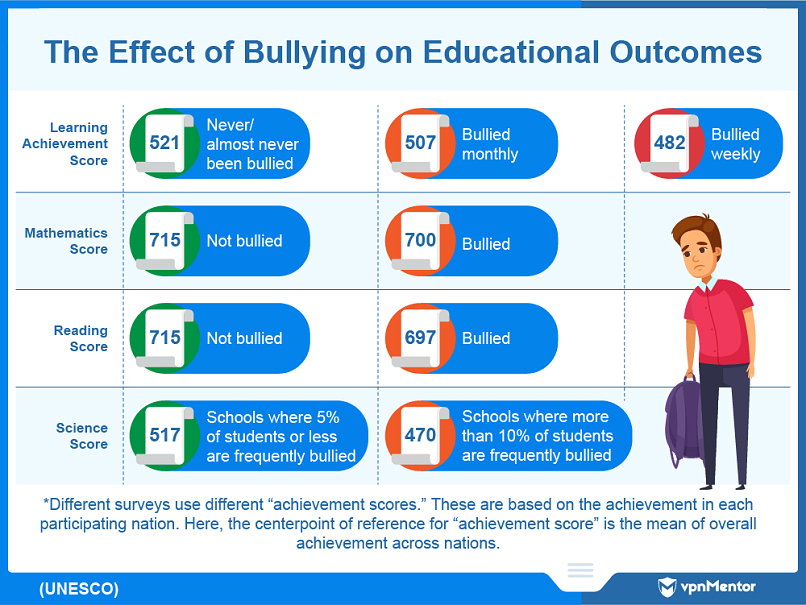
Religion is another frequent motivator for bullies.
4.6% of victims are targeted because of their religious affiliations.
According to one study, 30% of students with average social statuses are bullied.
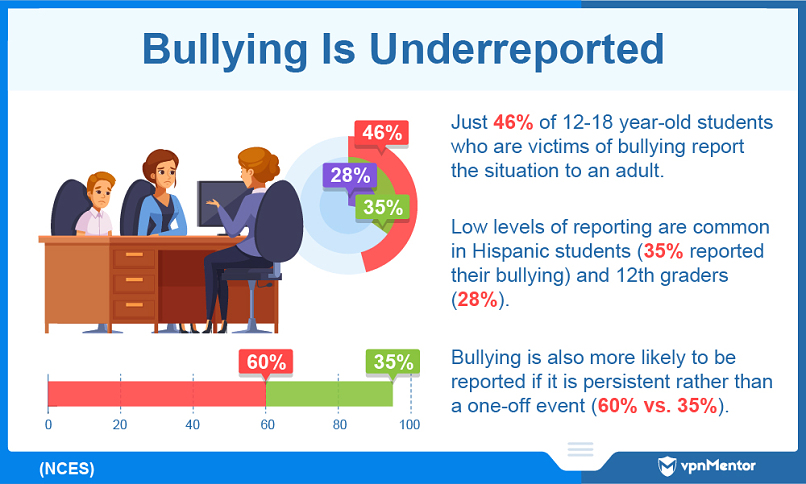
Meanwhile, students with a low or very low social standing are bullied far more often.
This trend is concurrent almost everywhere in the world.
Schools perceived to be “disadvantaged” have higher rates of bullying than more advantaged schools (PISA).
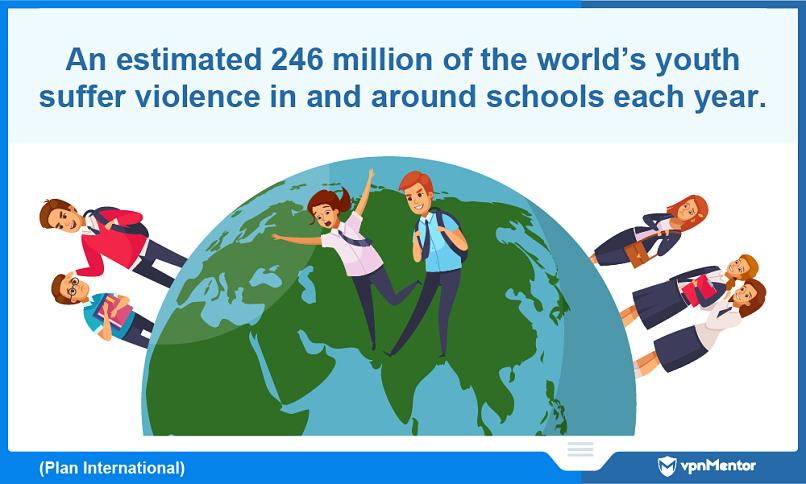
Students with lower social status are more likely to be cyberbullied than others.
33% of immigrant students are bullied as opposed to 26.3% of native-born students.
The same trend is visible in cyberbullying data.
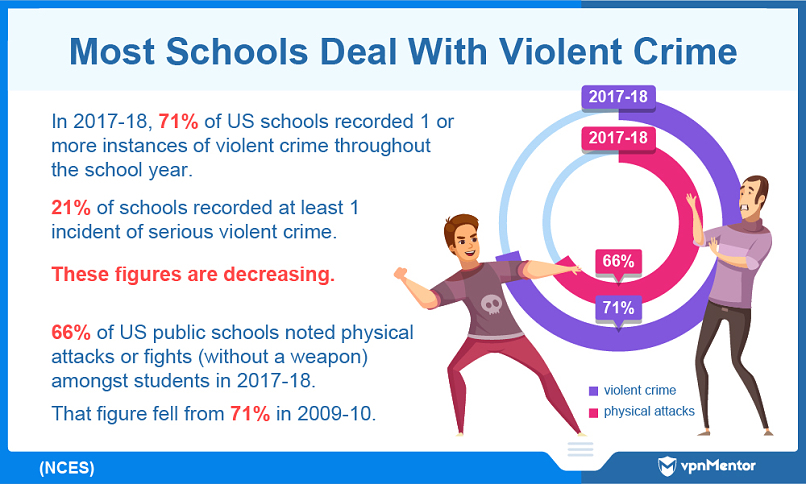
Immigrant students are cyberbullied via online messages 14.2% of the time compared to 9.4% of native-born peers.
Schools that have a better disciplinary climate have lower levels of bullying amongst students.
In other words, schools that do a better job of socializing students have fewer behavioral issues.
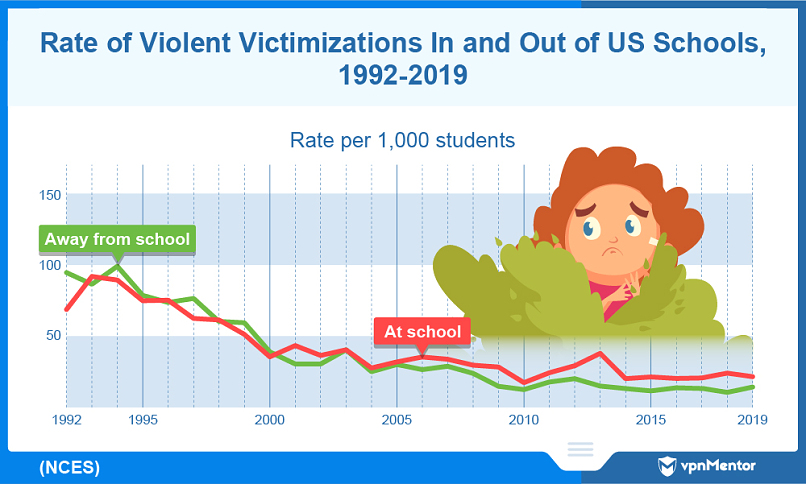
Bullying Can Cause Mant Risk Behaviors in Students
Bullying can cause significant psychological trauma and problematic behavior in students.
Bullied students may lose self-esteem, which can lead to substance abuse and self-harm.
In fact, this is the number one factor shooters cite as an explanation for doing the unthinkable.
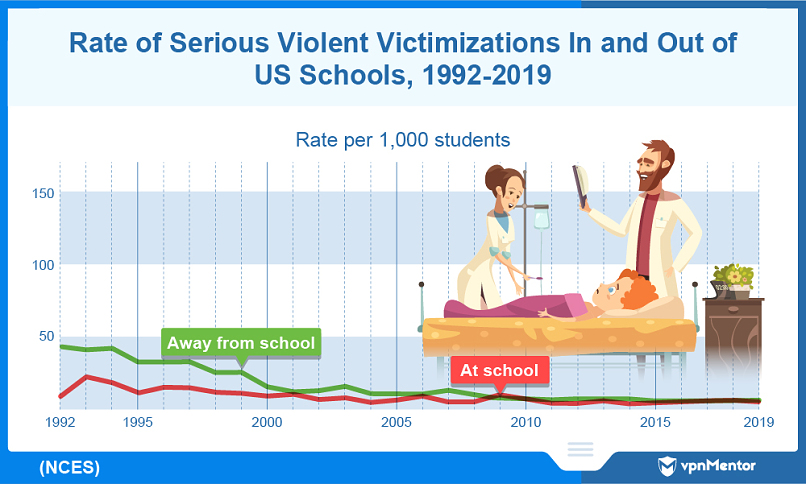
87% of school shooters underwent bullying before the shooting.
In many cases, shooters experienced extreme bullying over an extended period.
That doesn’t excuse the horrific nature of their crimes.
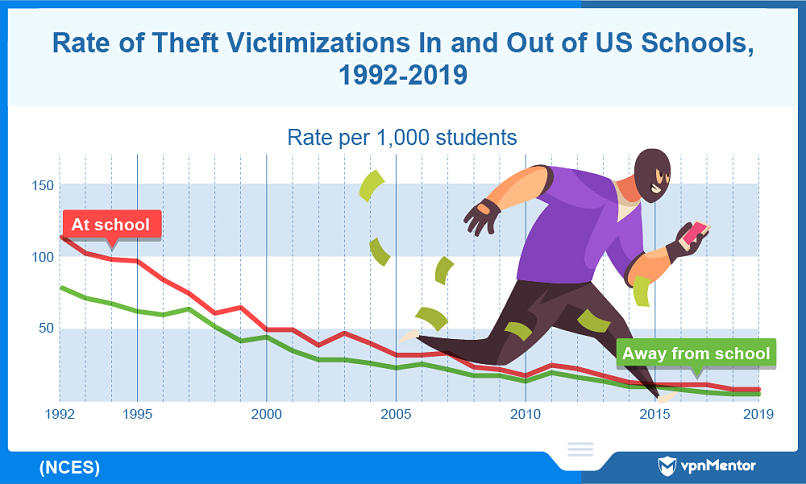
Still, it shows that bullying can cause enough mental torment to push people to the edge.
Bullies and Victims Can Adopt Problematic Behaviors
Bullies are more likely to use substances such as alcohol and cannabis.
The same can be said for bully-victims those who are both victims and perpetrators of bullying.
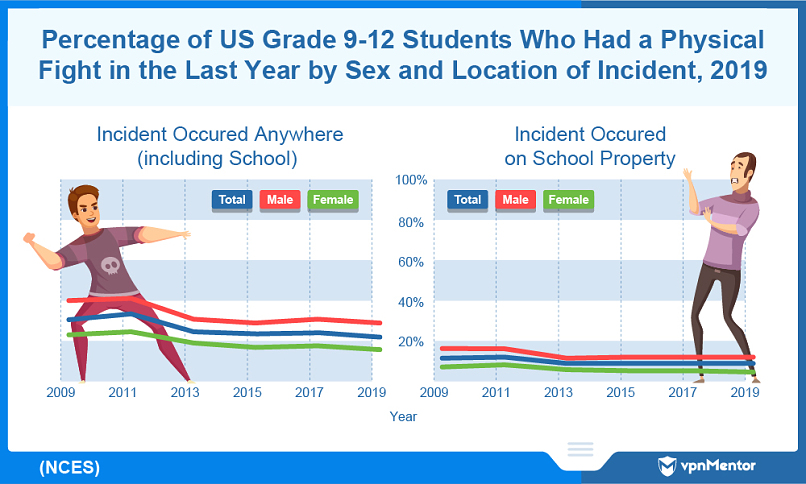
Just 15% of students who weren’t bullied said the same.
Bullying begins to affect the victim’s program across a range of areas.
They also suffer from greater anxiety on the day of a test.
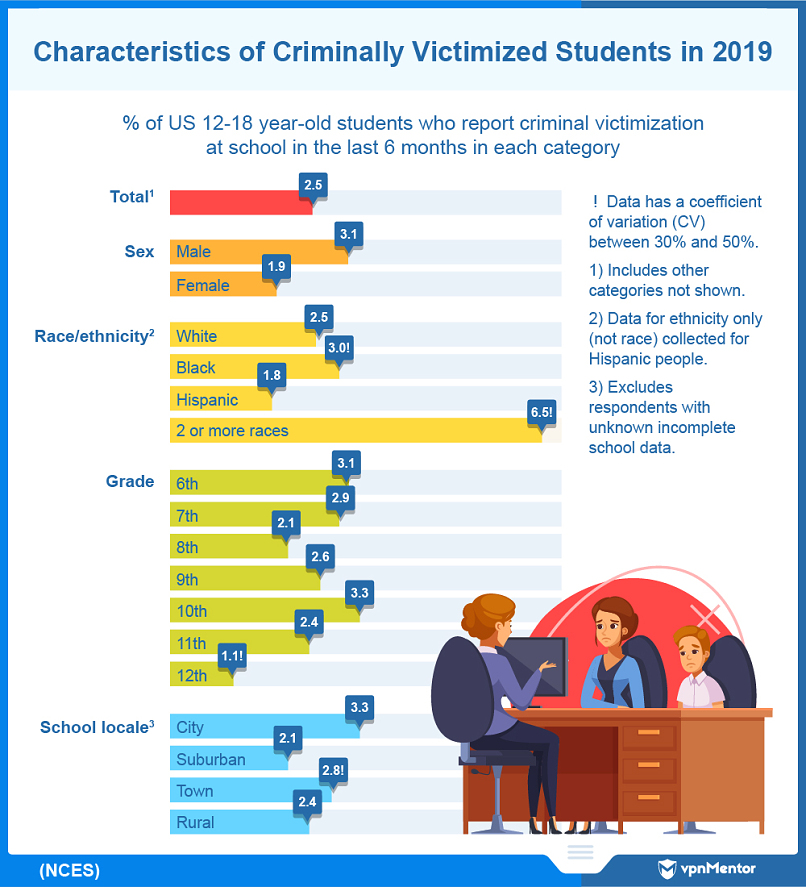
Bullying Damages Educational Outcomes
Bullying affects the learning outcomes of student victims.
The more students are bullied, the bigger the impact on their grades.
Scores were lower across mathematics and reading tests for Latin American students who had suffered from bullying.

Meanwhile, an OECD study found that bullying victims also faltered with their science scores.
Bullying Incidents Are Underreported
Bullying incidents typically go unreported.
This leaves bullied students with nowhere to turn for help.
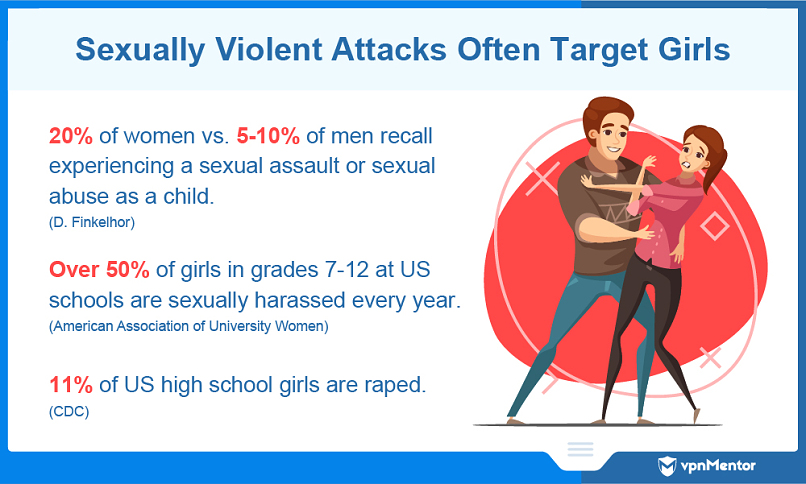
Thefts are non-violent incidents of stealing.
These crimes can occur across a range of different circumstances.
Perhaps a student attacks another student or steals from a teacher.
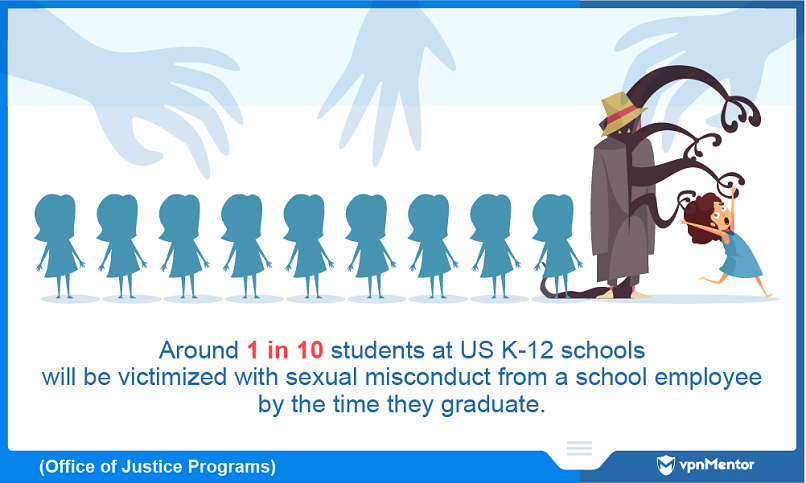
A teacher may even sexually or physically assault a student.
The Scope of School Violence
Violence in schools is not just an issue in America.
Violence is a problem in basically every school across the globe.
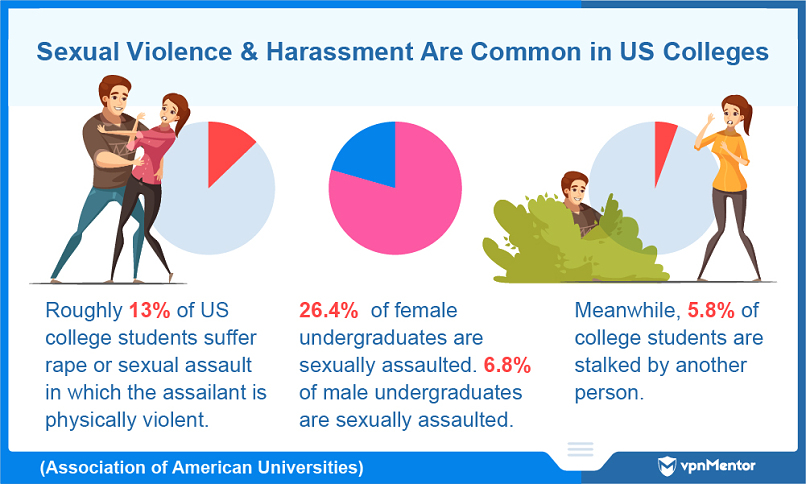
Nearly 250 million children and adolescents suffer from violence in or around school property every year.
How Many Schools in The US Experience Violent Crime?
However, the number of schools experiencing violent incidents is still very high.
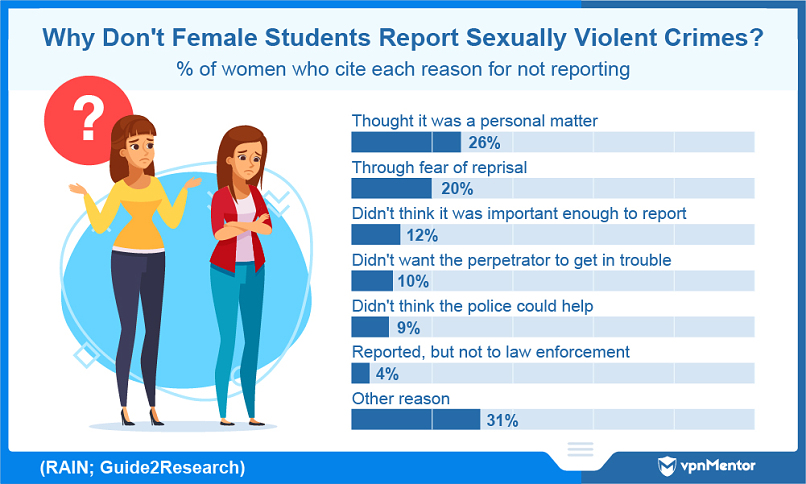
This number could be even higher if we factor in the possibility of underreporting.
Nevertheless, the downward trend evident in the data is a positive sign.
It demonstrates that government-led initiatives and the efforts of anti-bullying organizations are indeed bearing fruit.
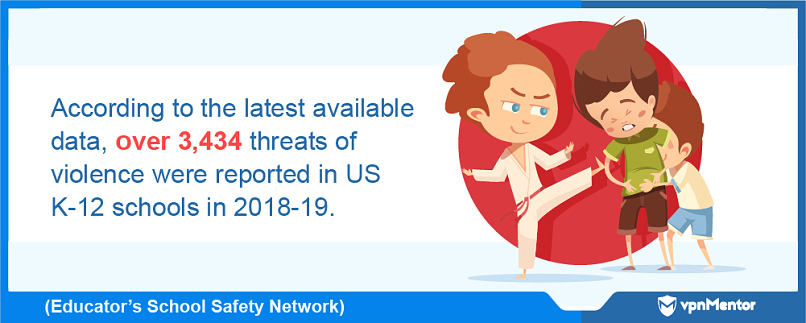
The Number of Violent Victimizations Is Falling
Violent victimizations have been decreasing rapidly over the last 30 years.
These types of crimes fell to 21 victimizations per 1,000 students.
That’s nearly an 80% decrease since 1992.
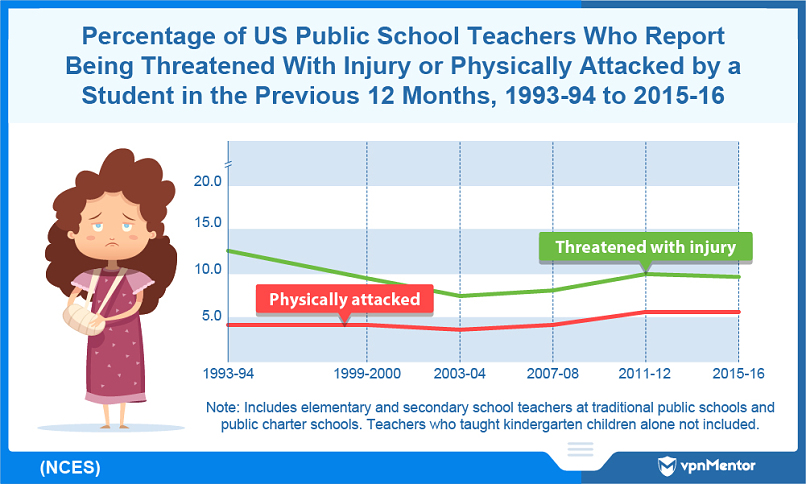
There were 5 victimizations per 1,000 students in 2019.
That means around 0.5% of school students experience a serious violent crime.
Again, theft incidents have declined massively, falling to just 9 incidents in school per 1,000 students.
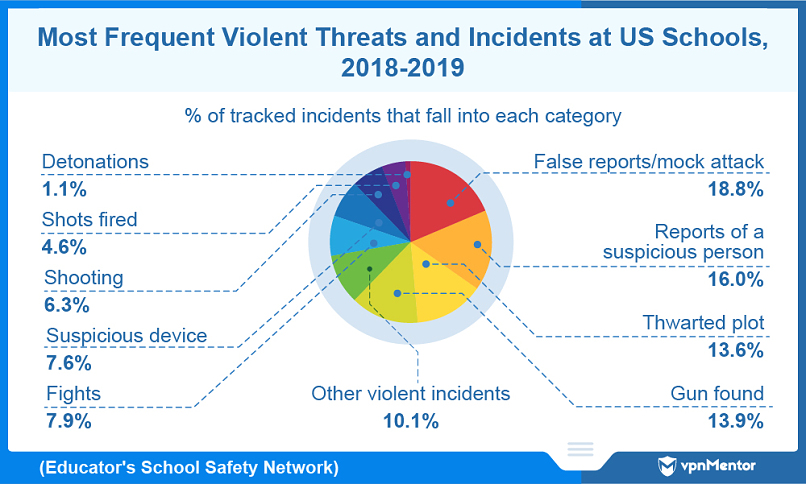
That being said, students usually experience more theft in school than outside of school.
Just 6 in every 1,000 students experience theft outside of school.
The Number of Physical Fights Has Fallen Slightly
Physical fights are extremely common among students.
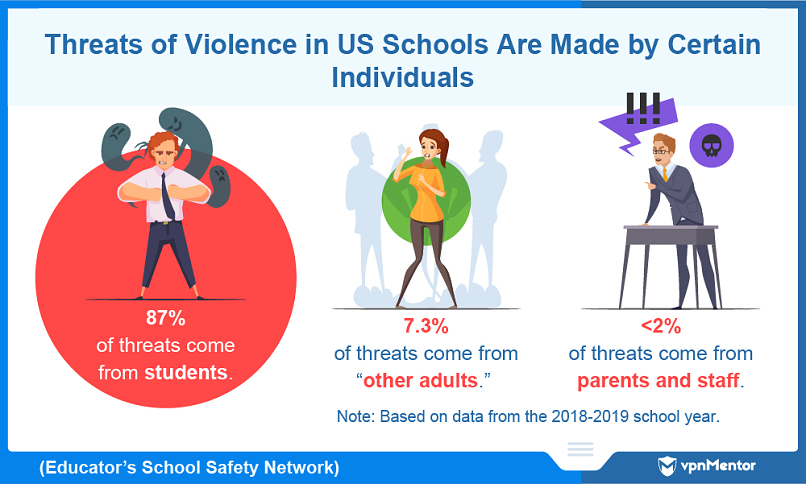
Physical fights can occur due to altercations between two students or develop from a bullying incident.
22% of 9-12th grade students claim they were involved in a physical fight in 2019.
That figure has fallen from 31% in 2009.
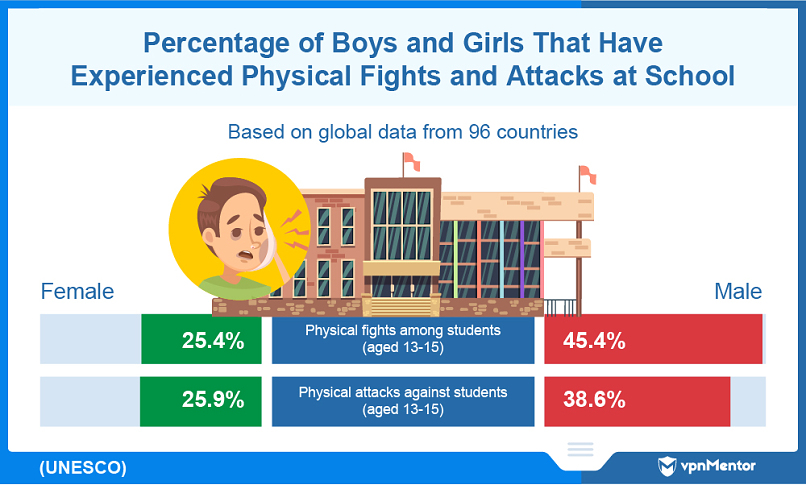
When asked about incidents on school property, 8% of US students said they fought on school grounds.
That’s a 3% drop in prevalence since 2009.
Violent students are more likely to attack or rob mixed-race students in or around school premises.
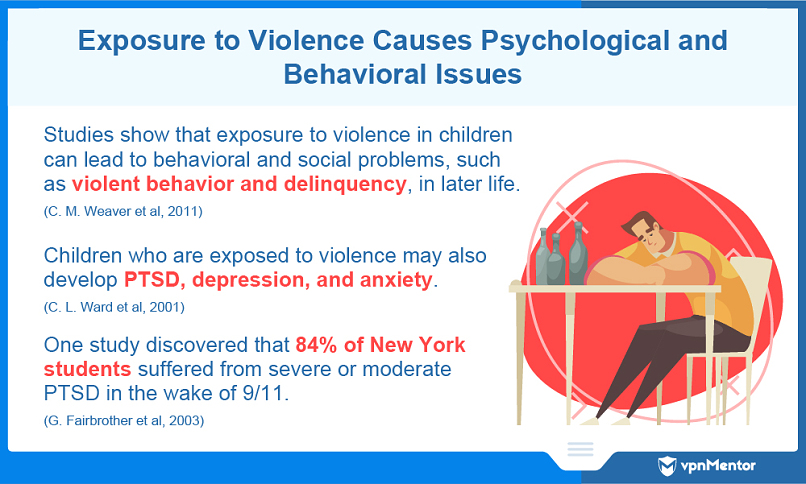
6th, 7th, and 10th graders are more likely to be victimized.
Urban areas are hotbeds for attacks and thefts compared to the countryside.
Students at schools in cities and towns report incidents at a higher rate than those in rural schools.
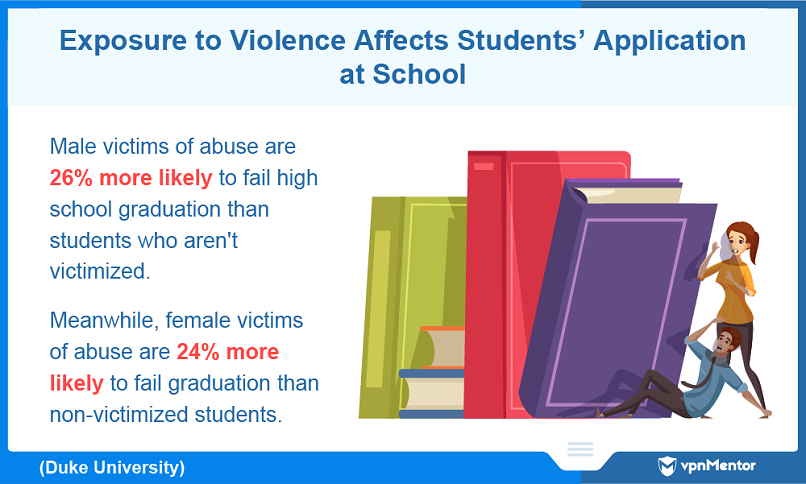
Sexual assault is any sexual contact or behavior that was not consented to by the victim.
This may include attempted rape, fondling or unwanted touching, and forced sexual acts such as oral sex.
Sexual assault could occur between students, or teachers and students.

Sexual Violence Mainly Affects Girls
Women are targeted with sexual assaults more often than men.
According to the Office of Justice Programs, 89% of sexual assault victims are women.
This issue affects female students too.
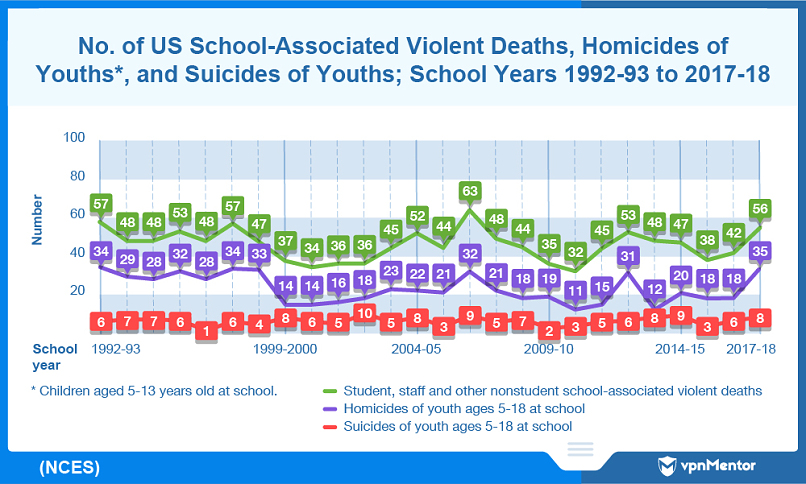
Sexual harassment is any verbal, nonverbal, or physical conduct that is sexual.
Sexual Misconduct from Teachers Is Common
Parents trust teachers to keep their children safe.
Unfortunately, teachers sometimes abuse this trust and engage in sexual misconduct towards students.
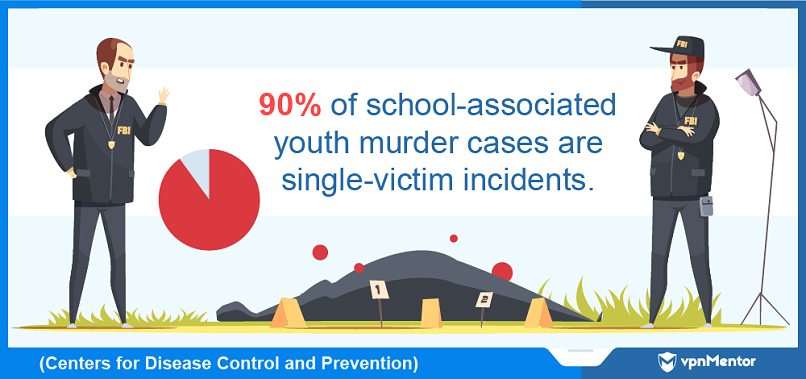
This could be forms of harassment or forcible sex offenses, such as rape and sexual assault.
These crimes can significantly damage the mental health of victims.
Sexual Violence in Colleges Is Common
Sexual violence is a big problem at US colleges.
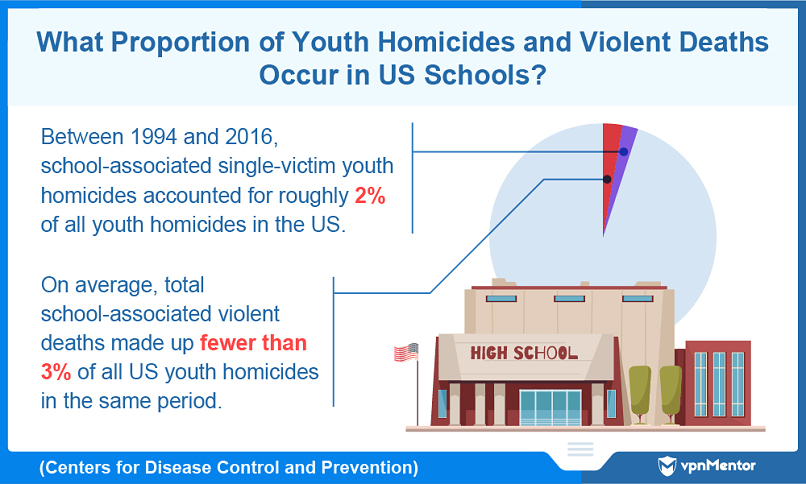
This form of sexual violence was second only to burglaries in the NCES review.
There were around 7.1 forcible sex offenses per 10,000 college students in 2018.
Sexual assault victims sometimes do not believe the incident was significant enough to report.
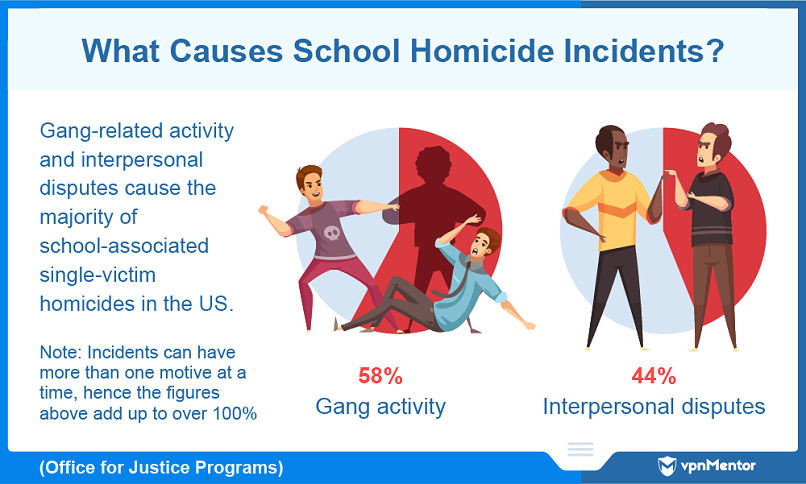
Others don’t trust the police to solve the issue.
How Often Do Students Threaten Each Other?
Nearly 3,500 violent threats were tracked in US K-12 institutions in the 2018-2019 school year.
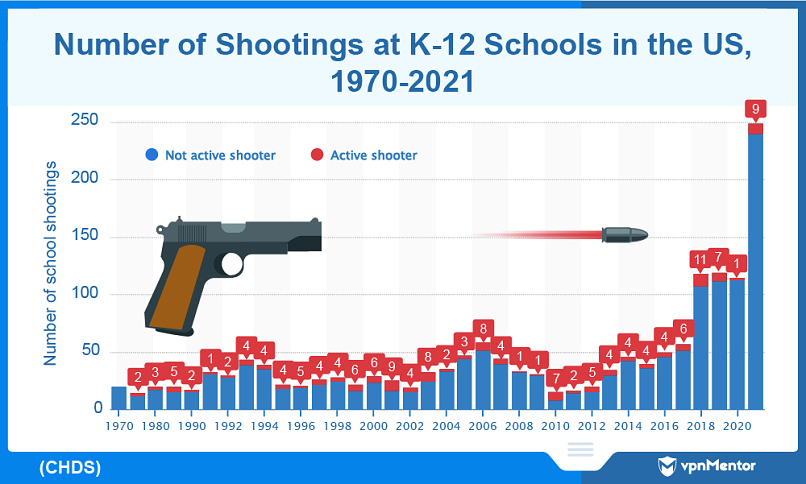
The vast majority of these incidents occur between students, or teachers and students.
Students Threaten Teachers… a Lot
Teachers are threatened with violence from students all the time.
1 in 10 teachers in the US experienced a threat from a student in the 2015-2016 school year.
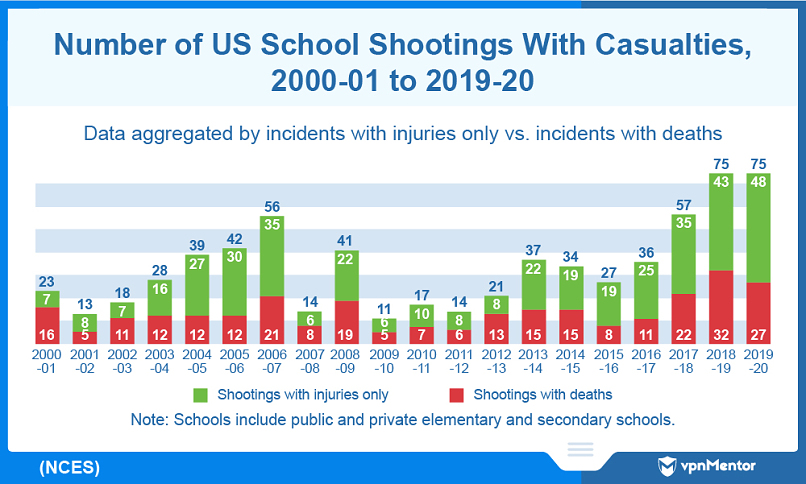
6% of teachers were ultimately attacked by a student.
Students threaten each other with physical violence as well.
6% of students reported being threatened with a weapon in 2017.
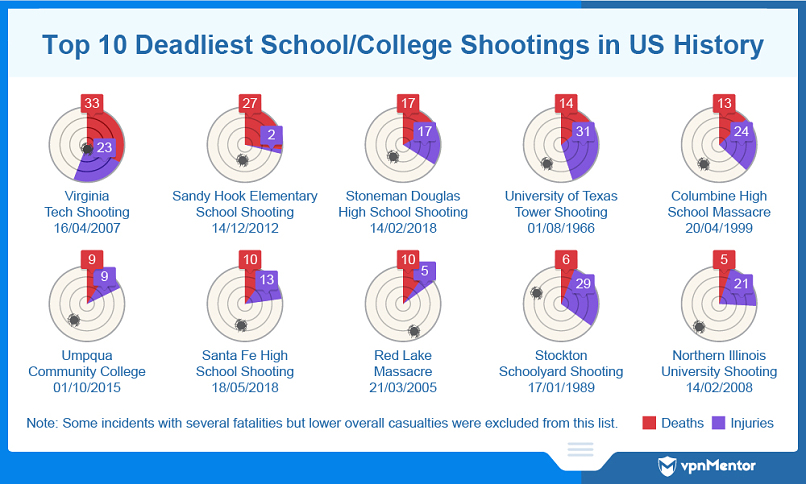
This is, in part, the reason why mock attacks are so common.
Fights are the most common violent incidents, while 6.3% of tracked incidents involved a shooting.
According to the ESSN, school shooting statistics were lower than expected.
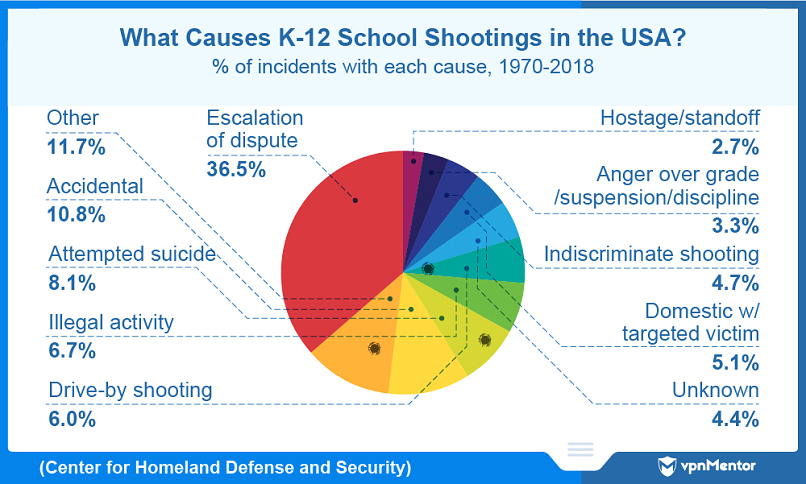
However, the prevalence of weapons-related threats and incidents overall suggests this is still a serious issue.
The Educator’s School Safety connection found roughly 6 bomb threats for every 10 gun threats.
44. Who Makes Violent Threats in US Schools?

In schools, students are behind violent threats more often than not.
87% of violent threats come from students.
It’s far less likely for parents or school staff to threaten other people in school with violence.
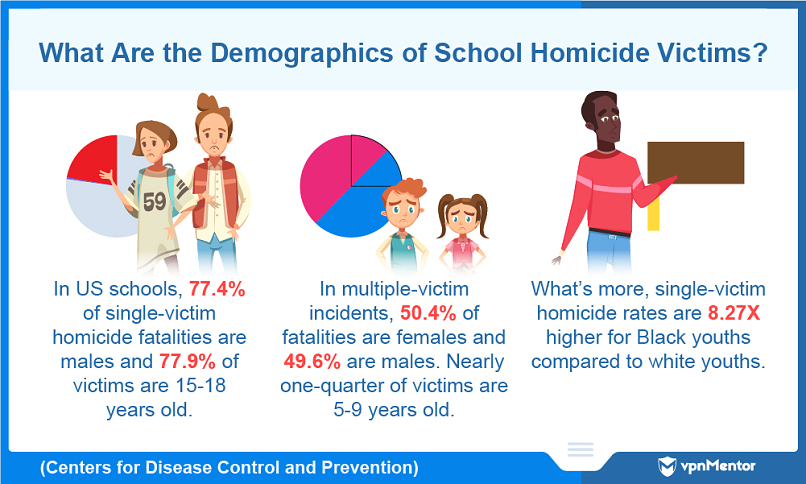
Just 2% of incidents can be classified in this category.
Surprisingly, a reasonable portion of threats (7.3%) come from “other adults.”
These can be people who have gained access to school grounds to conduct criminal activities.
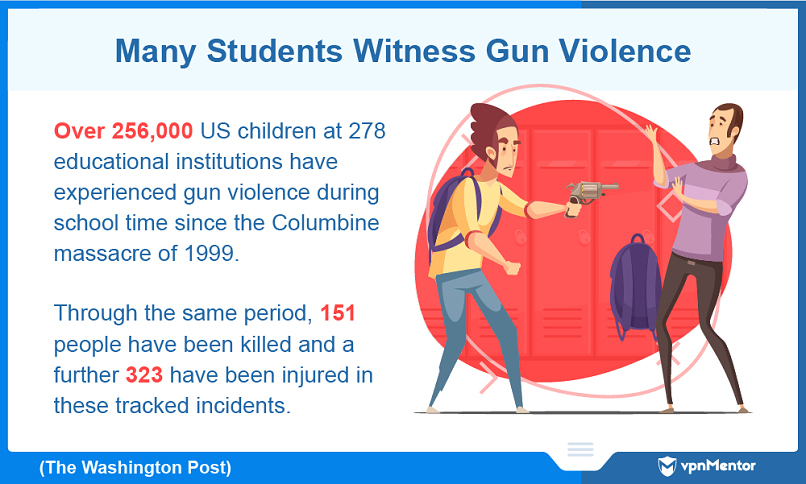
45.4% of surveyed boys said they had been involved in physical fights compared to 25.4% of girls.
Nearly 40% of boys note that they have been physically attacked as opposed to 25.9% of girls.
Why is this, exactly?
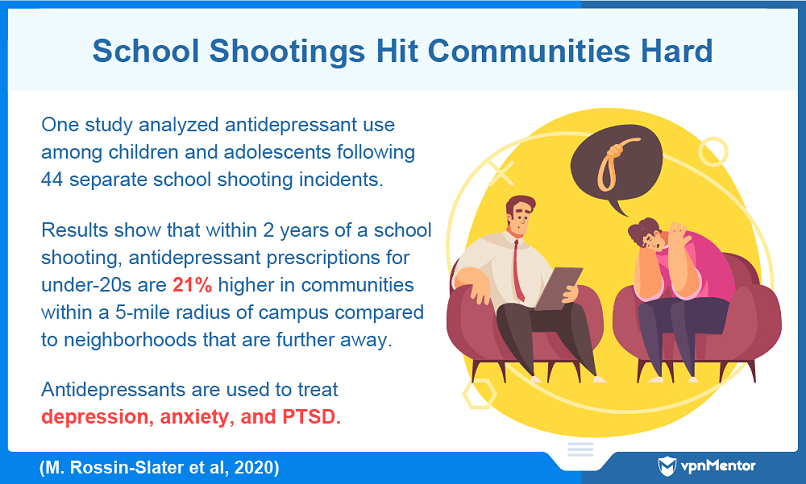
A 2014 study found that around 80% of people arrested for violent crimes are men.
Meanwhile, male on male violence makes up 65% of homicide cases in the US.
Violence Has Behavioral, Social, and Psychological Impacts
Victims of violence suffer from regressive social and mental states.
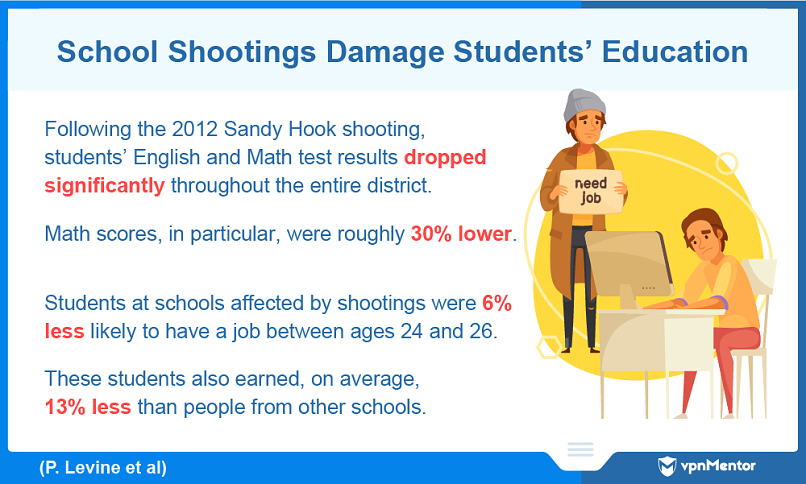
Anxiety and depression, substance abuse, and even impaired behavioral functioning are all common effects of violence.
Whether experienced first-hand or witnessed, exposure to violence can bring about these effects in students.
Victims of childhood violence may completely lose focus on their studies.

These students are more likely to drop out or fail to graduate.
They may even exert violent behaviors later in life.
3 separate studies have come to this very conclusion in recent years.
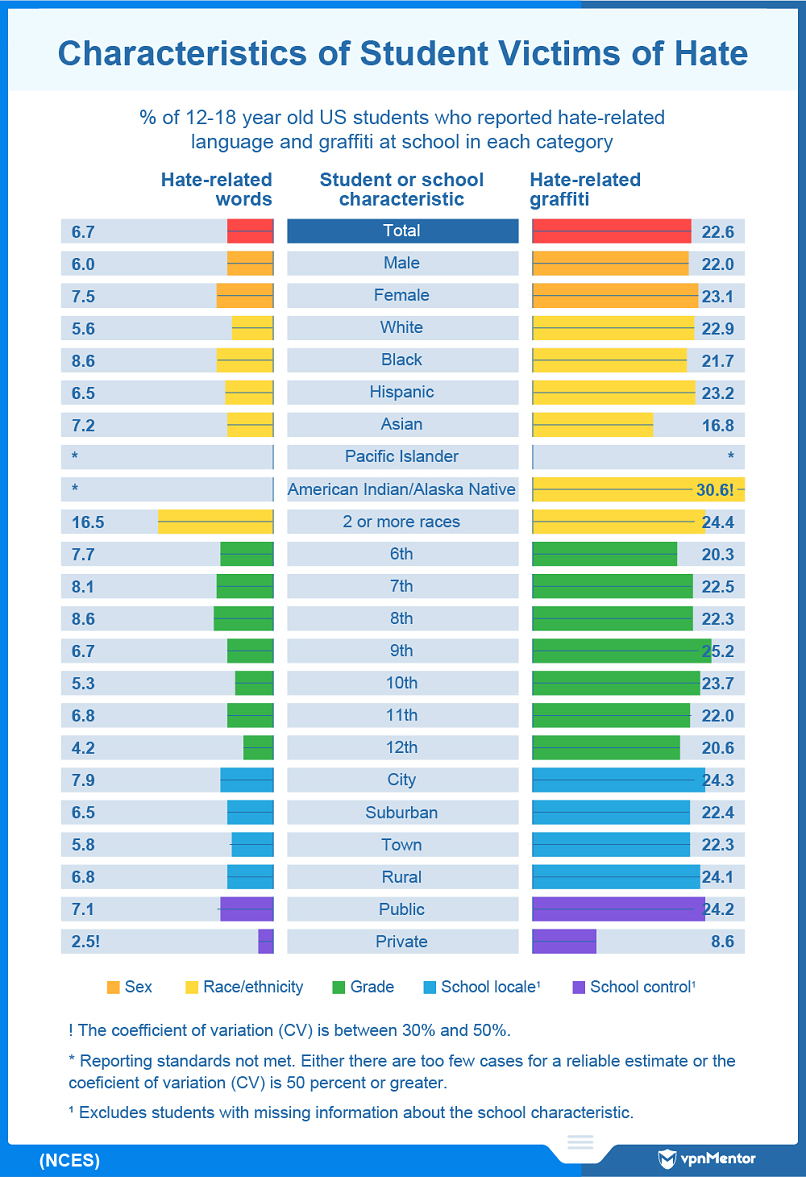
These studies show that students don’t even need to be victims of school violence to be affected.
Sometimes the collective trauma experienced by communities at large is enough to cause damage.
Ultimately, the effects of violence on mental health and cognitive skills lead to impaired educational outcomes for students.
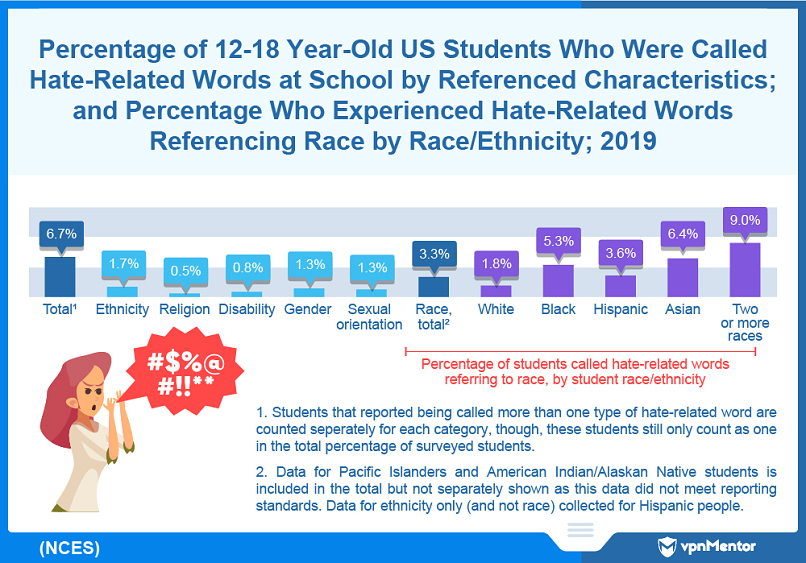
In some cases, suicides can occur because of bullying incidents at school.
Homicides and school shootings are avoidable acts of violence facilitated by some childrens' access to firearms.
How Many Violent Deaths Occur at US Schools?
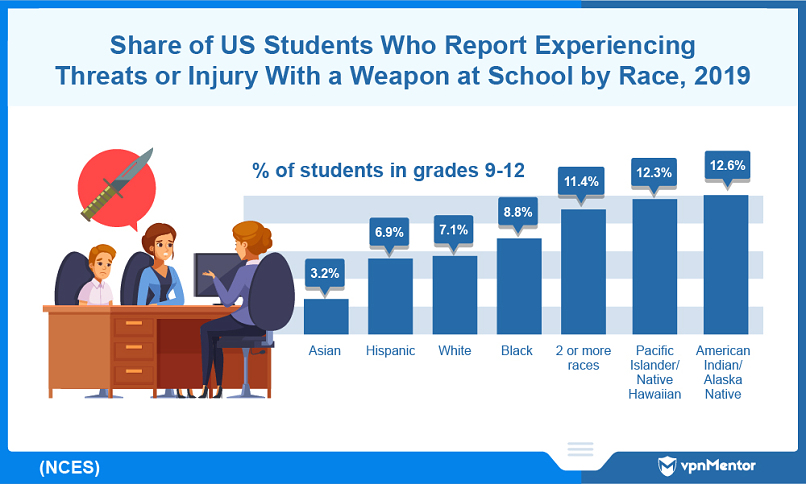
This data reveals a worrying trend in US schools.
Homicides Normally Involve One Victim
Despite increasing multiple-victim incidents, most school-related youth homicides affect a single victim.
This is contrary to popular belief.
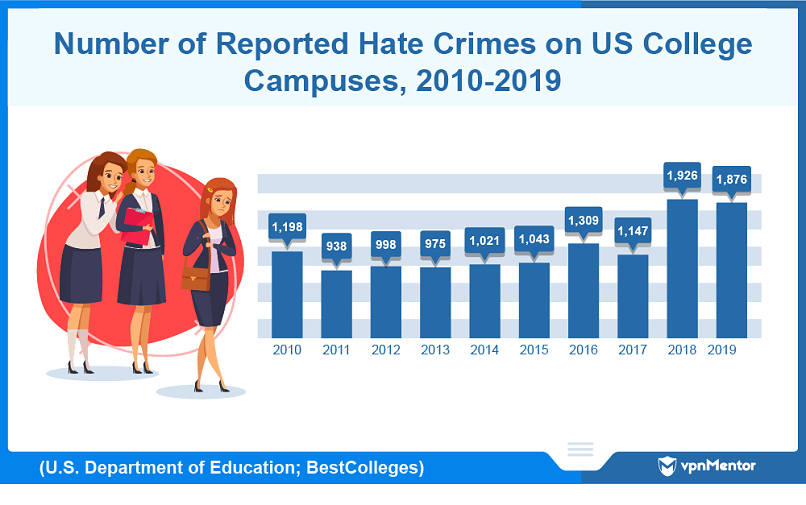
These events get more exposure, yet single-victim incidents are far more frequent.
What Percentage of All Youth Homicides Occur in Schools?
Single-victim homicides in schools make up less than 2% of all youth homicides.
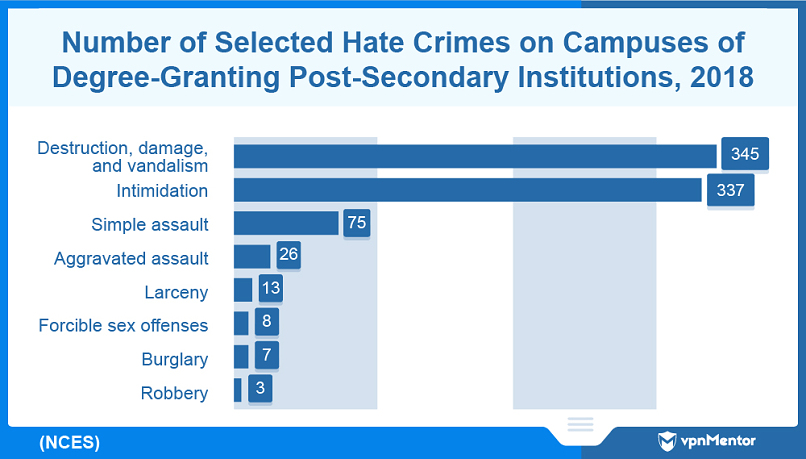
Generally, all school-associated violent deaths account for less than 3% of youth homicides through the same period.
Gang activities account for the majority of homicide incidents in schools.
Interpersonal disputes were the second most common cause of school-associated homicides.
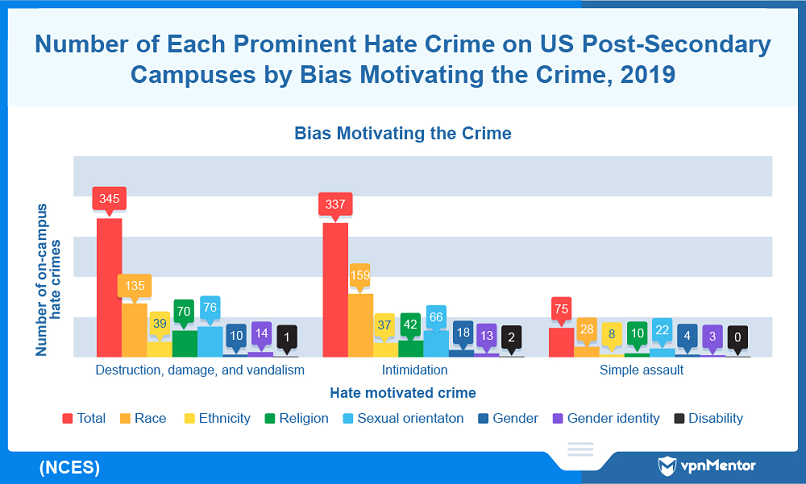
How Many School Shootings Happen Every Year?
School-associated homicides can be the result of school shooting incidents.
School shootings have occurred in record volumes over the last four years.
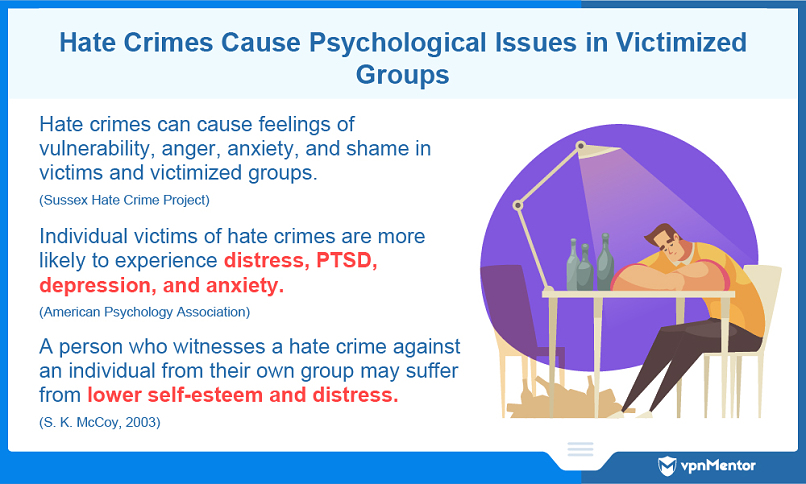
2021 was the worst year for US school shooting incidents on record.
There were 249 total school shooting incidents throughout 2021.
That’s more than double 2020’s total.
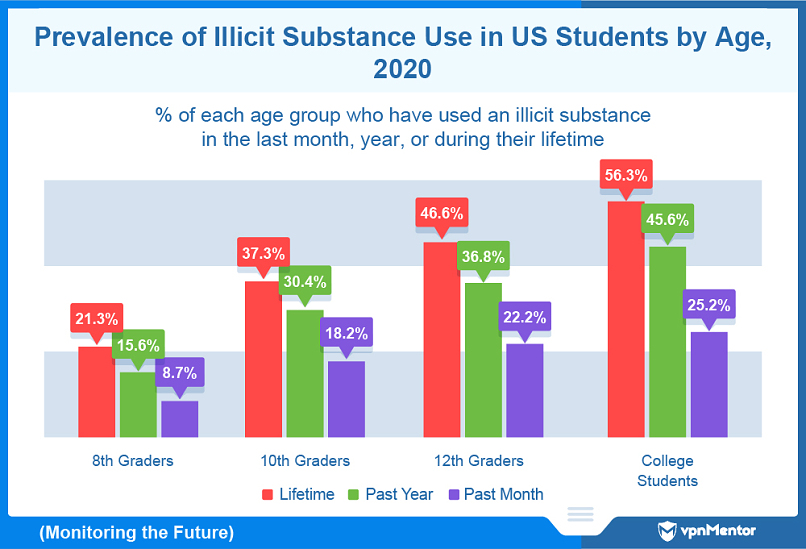
More children potentially have access to firearms than in previous years.
Worse still, these weapons may not be stored securely by inexperienced gun owners.
This is an ugly trend in US school crime.
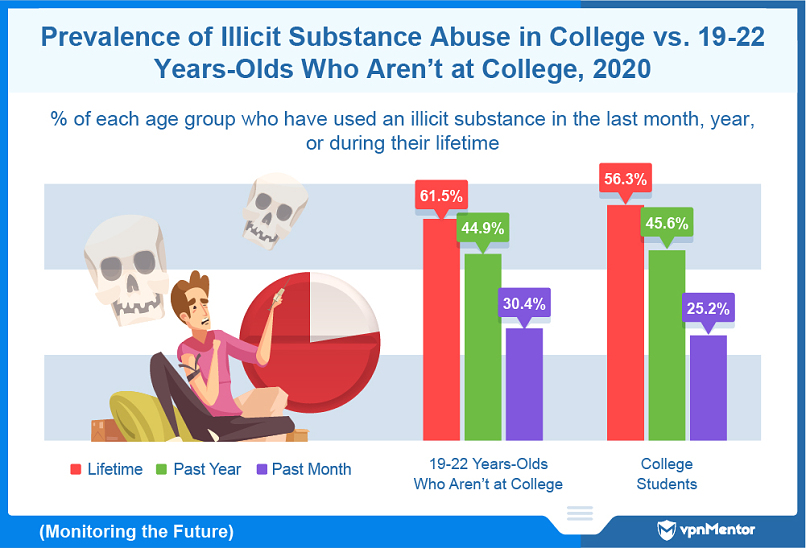
75 shootings involved deaths and injuries in the 2018-19 and 2019-20 school years.
In 2018-19, 32 incidents involved deaths, and 27 incidents involved deaths in 2019-20.
The K-12 School Shooting Database provides detailed annual updates on the volume and impact of school shootings.
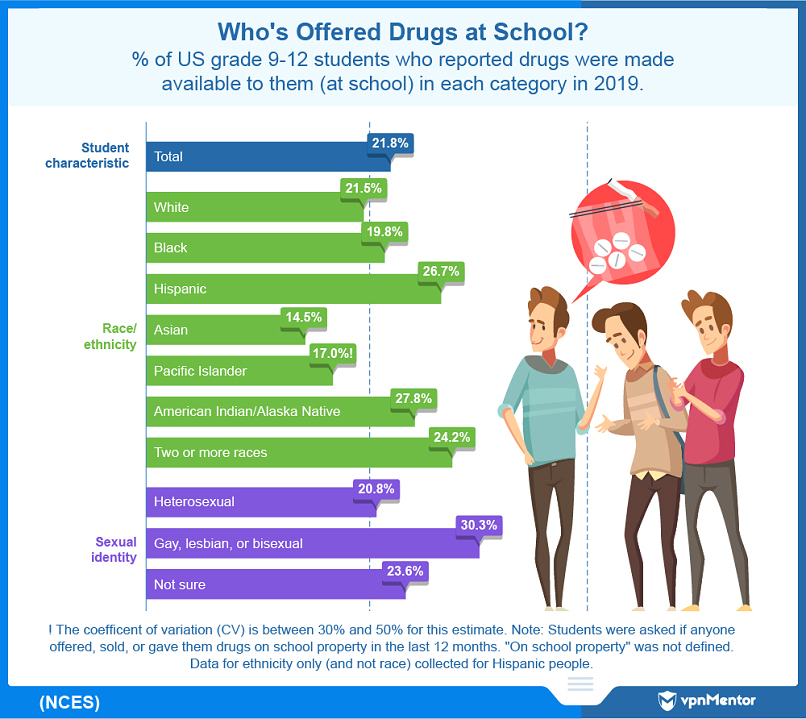
A further 277 incidents have resulted in at least one injury.
That means 678 total school shootings resulted in injury or death.
Take the 1999 Columbine massacre, a tragedy that’s still traumatic for so many people.
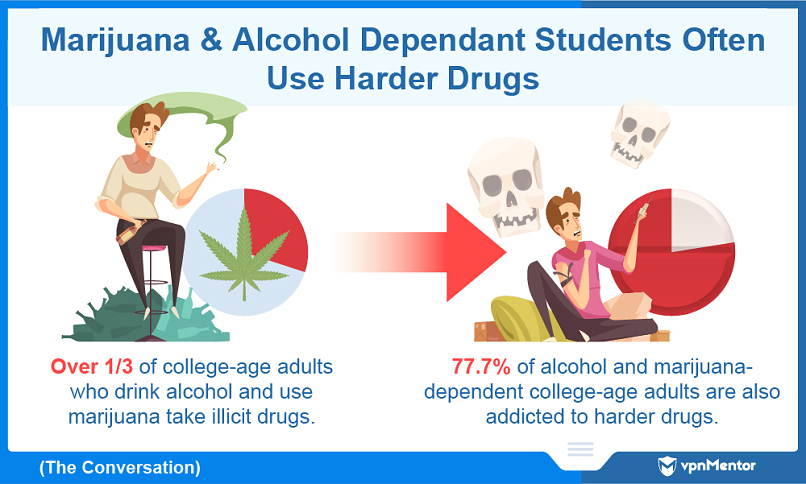
The Virginia Tech shooting is the deadliest school shooting in modern American history.
23 year-old Seung-Hui Cho locked campus buildings to exact an indiscriminate and devastating attack.
What Causes School Shootings?
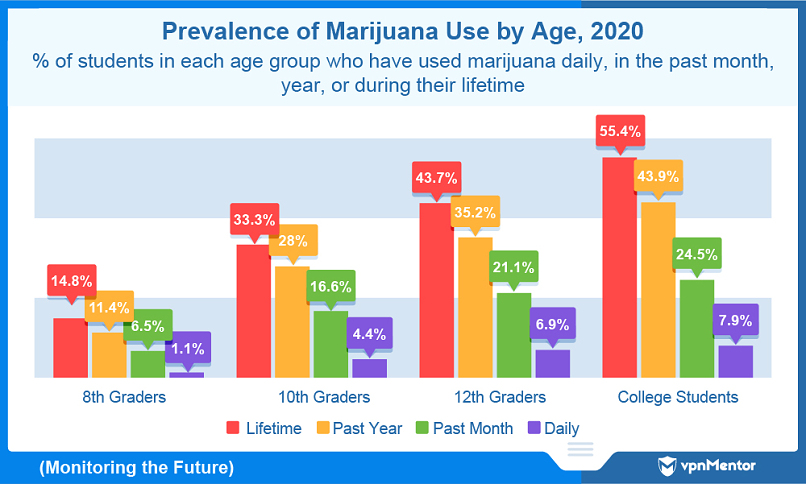
But what are the real reasons shooters turn to gun violence?
Domestic incidents make up around 5% of school shootings.
Students who are angry over their grades account for 3.3% of incidents.
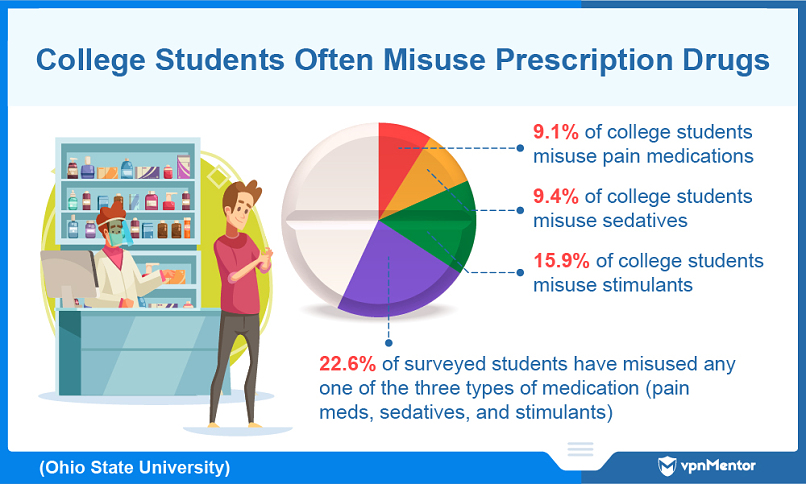
How Old Are US School Shooters?
Between 1970 and mid-2020, most school shooters were 14 to 18 years old.
679 out of 1,050 total school shooters fell within this age range, according to CHDS data.
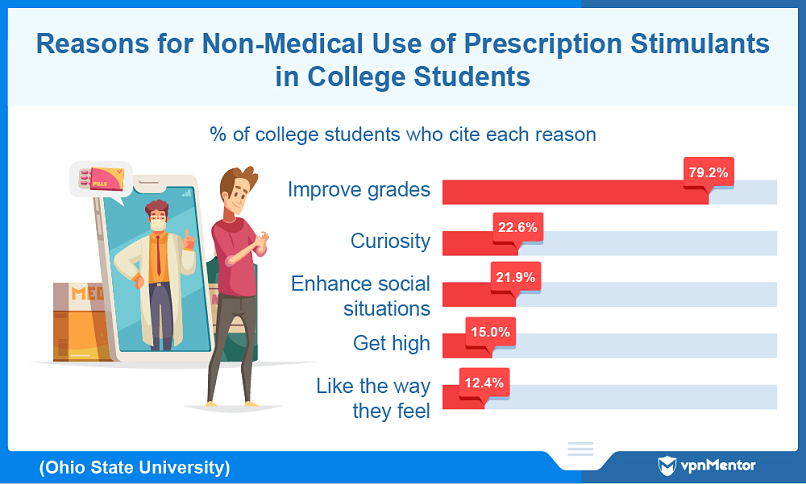
Outside of the 14-18 age range, many shooters were also aged 31 or above.
125 school shooters were over the age of 31.
Many of these people could be staff members or adults who have gained access to school grounds.
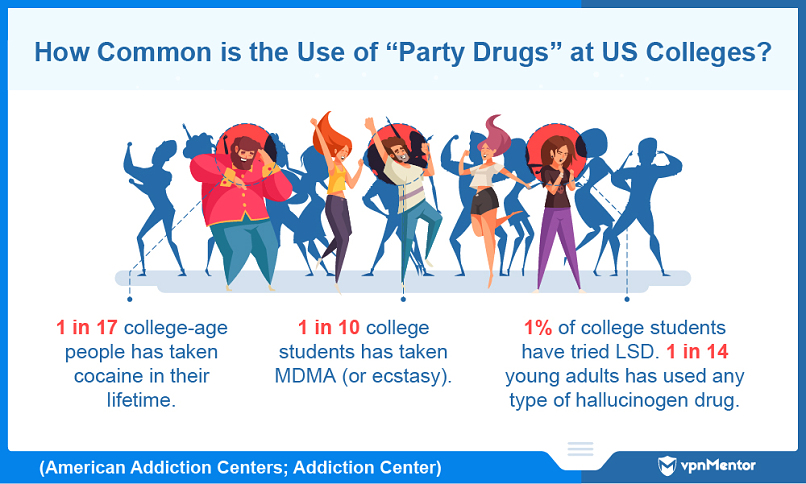
While there are school shooters who are women, most school shooters are men.
In 2017, 13 active shooters at post-secondary educational institutions were male, and 2 were female.
Homicide Victims: Demographics
Youth homicide victims usually have a similar demographic makeup.
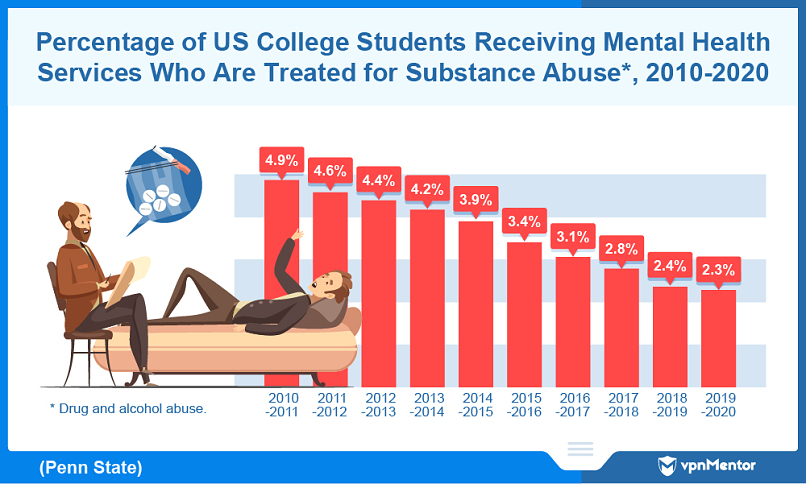
For a start, single homicide victims are usually male.
Single victim homicides are often targeted attacks resulting from a dispute.
According to several studies, men are more likely to perpetrate crimes and be victimized by violence than women.
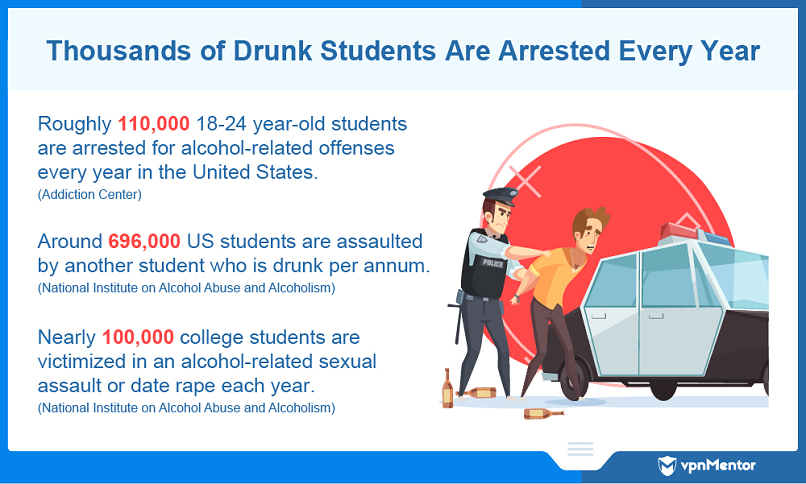
School homicide data is concurrent with these results.
Alternatively, multiple-victim homicides are usually indiscriminate attacks, such as school shootings.
In this case, victims are evenly distributed between males and females.
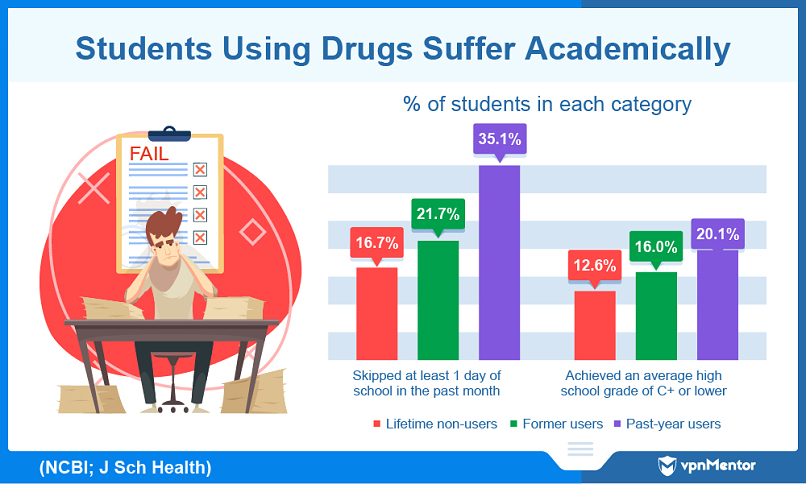
Data also shows that Black children are victimized by homicides far more often than white children.
Hundreds of Thousands Are Affected by Gun Violence
The casualties in school shooting incidents are not the only victims.
Hundreds of thousands of US school children have been subject to gun violence since the Columbine massacre of 1999.
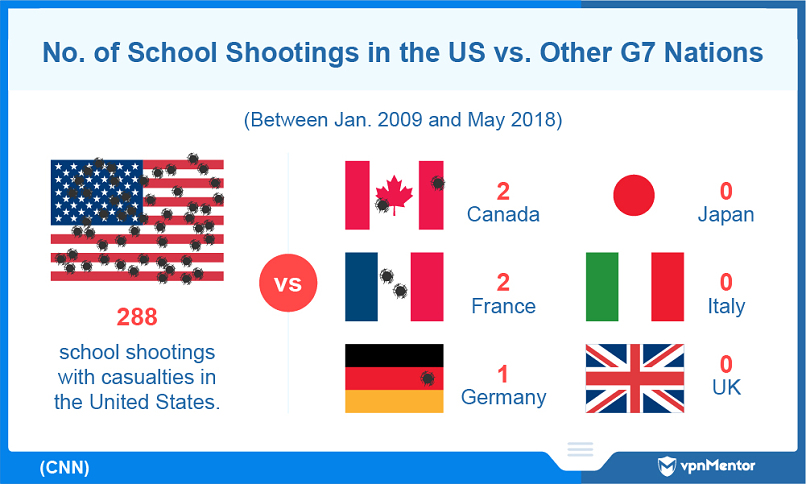
No parent wants their child to see this side of society at school.
Many children faced with gun violence must deal with resulting trauma and mental health issues.
This trend could be seen following the first anniversary of the Marjory Stoneman Douglas High School Shooting in 2019.
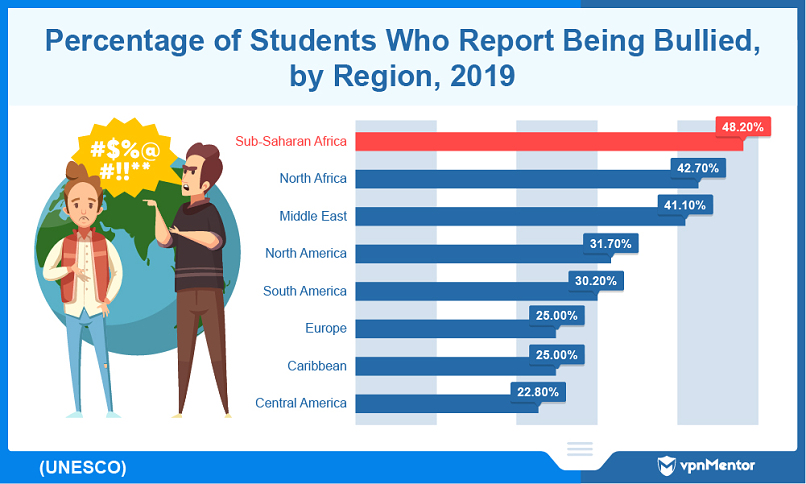
Within days of the anniversary, 2 students at the school committed suicide.
Hate Crimes & Racism
Hate crimes are commonplace in US schools.
Here are the latest stats on hate crimes in US schools.
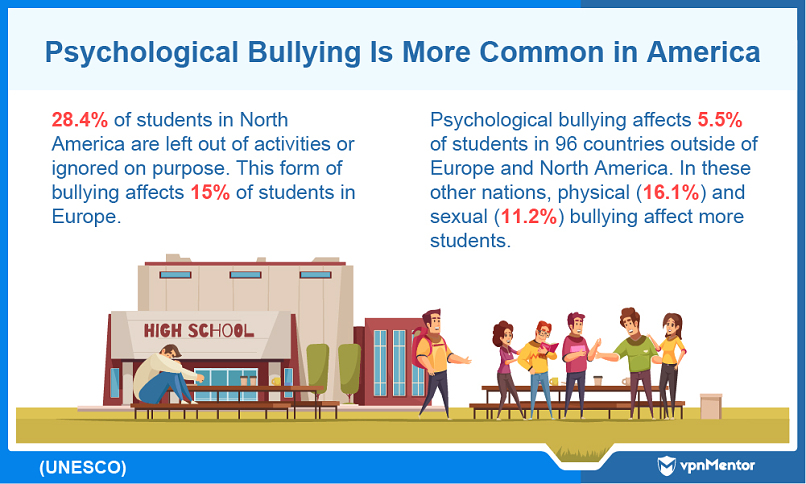
How Common Are Hateful Words at School?
According to the US.
The numbers show that incidents of hate speech have been on a steady decline since 2009.
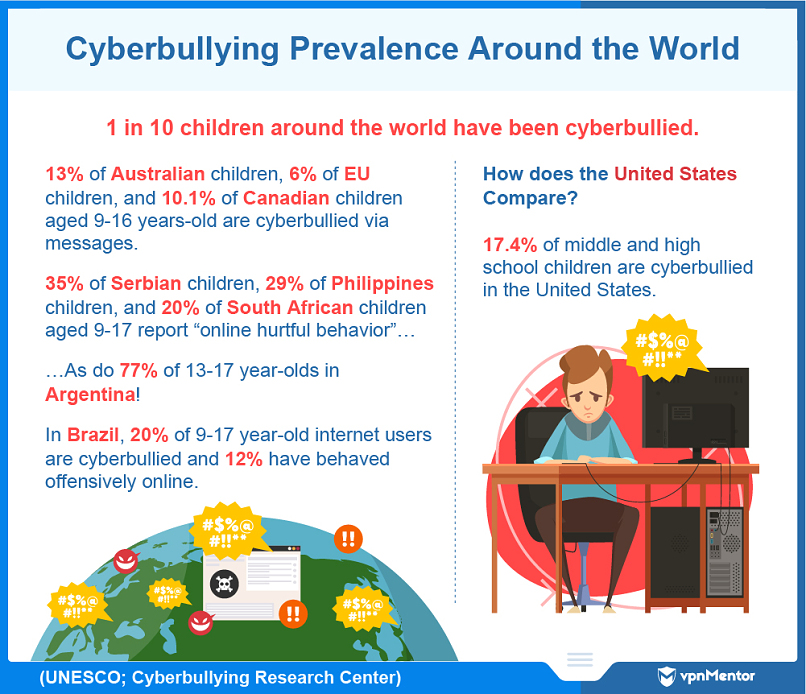
In 2009, 9% of students reported experiencing hate-related words.
The same trend can be inferred from data on hate-related graffiti.
29% of students said they had seen hate-related graffiti in 2009.

In 2019, that figure had lowered to around 23% of students.
Hate at School: Victim Characteristics
Students with certain personal characteristics are more vulnerable to hate-based language.
The data shows that girls experience hateful words at a higher rate than boys.
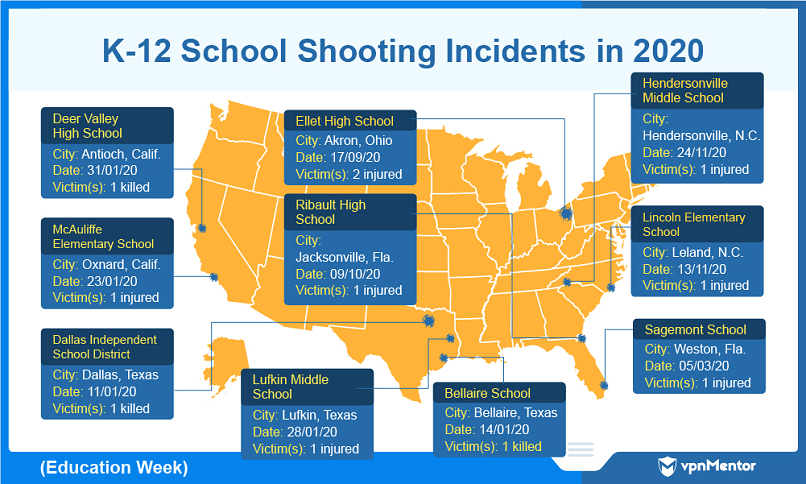
8th graders, city schools, and public schools all report higher hate-related words.
Between 2009 and 2019, white students reporting hate-related words decreased from 7% to 5.6%.
Hate-speech targeting Hispanic students also decreased from 11% to 6.5% between 2009 and 2019.
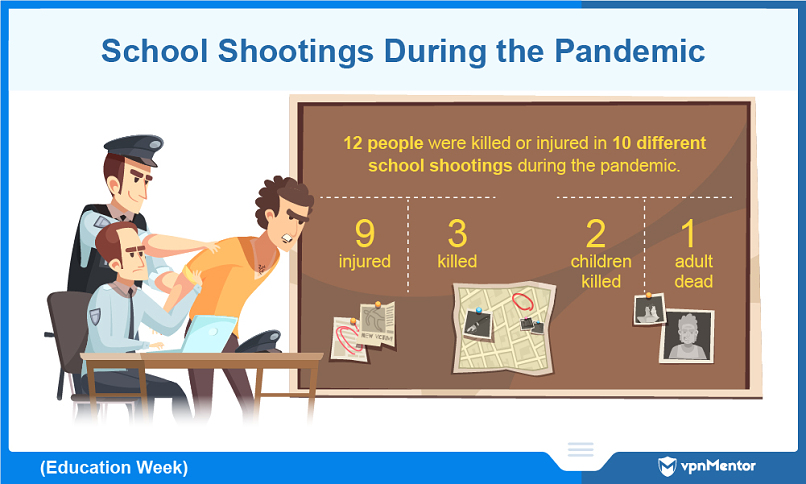
On average, city and rural schools contain similarly high volumes of hate-related graffiti.
Public schools are more likely to have this graffiti than private schools.
Racist Language at School
As mentioned, hate-related words include racist language.
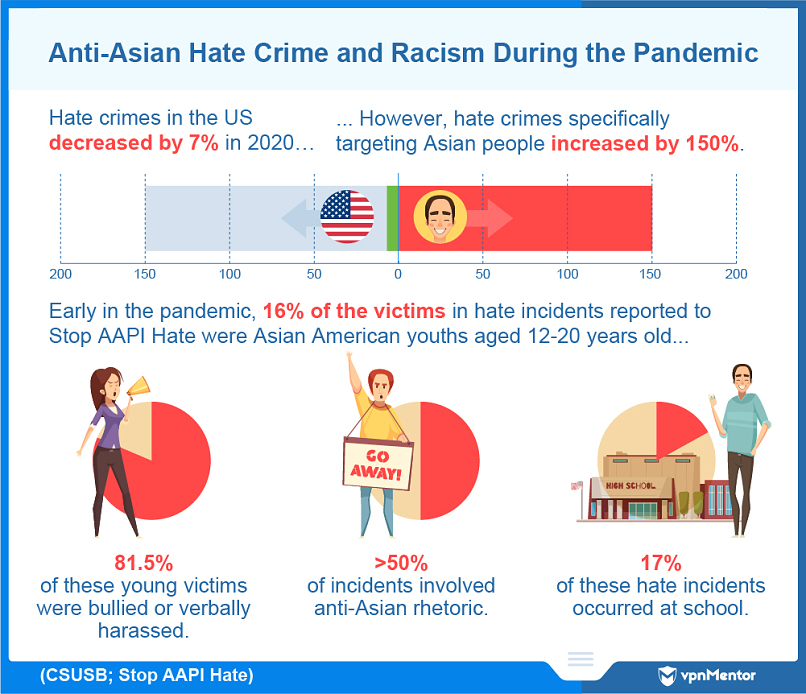
Non-white students are much more likely to be exposed to racist language.
1.8% of white students experience racial hate speech.
We need updated statistics to highlight the effect of this developing issue on US college campuses.
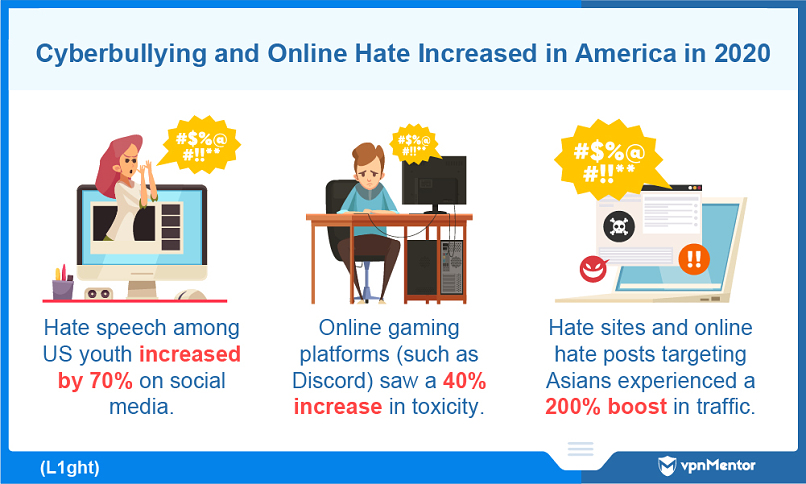
College Hate Crime Is Getting Worse
Nearly 2,000 hate crimes were committed at US colleges in 2019.
Colleges and schools often represent broader social trends outside of campus boundaries.
According to the FBI, there were 7,759 hate crime incidents in 2020 a 6% increase over 2019.
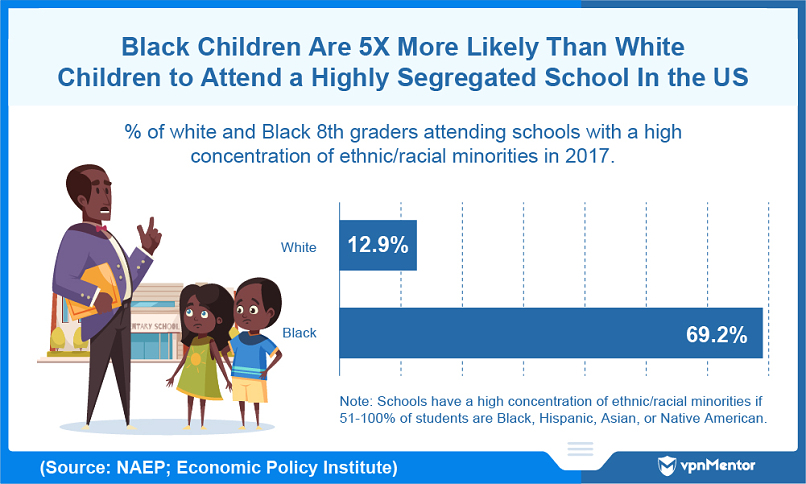
US hate crime figures have been rising since 2014.
Hate Crimes On College Campuses
Note: The NCES uses two different definitions of hate crime.
The above definition classifies hate crime incidents on college campuses.
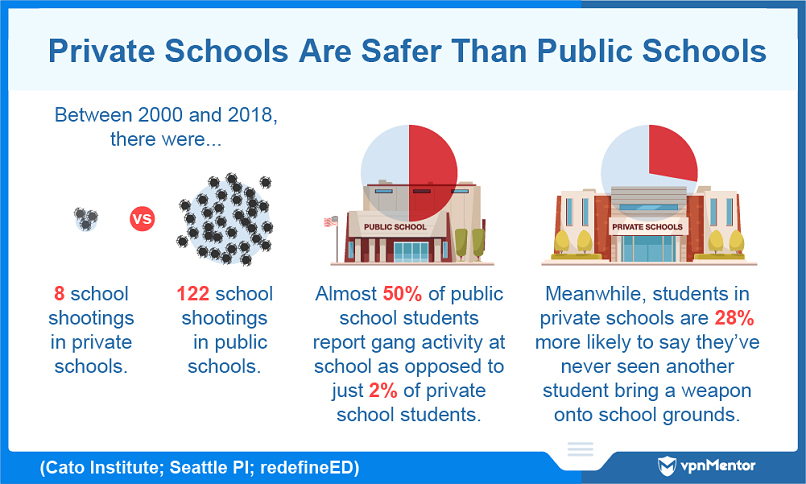
Almost 350 incidents of hate-motivated vandalism occurred on college campuses in 2018.
A combined 814 of these crimes occurred on college campuses in 2018.
In intimidation hate crimes, race was the motivator nearly 2.5X as often as any other factor.
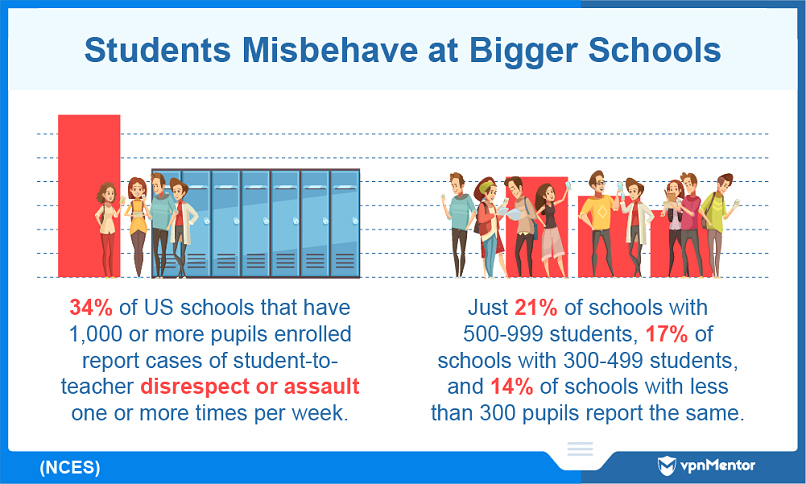
For simple assaults, the difference was less pronounced, but race was still the driving factor.
Drug & Alcohol Abuse
How common is substance abuse among US students?
And what effect can it have on their education?
Here are the numbers on substance use in US schools and colleges.
Studies have shown that substance use is linked witheducation inequalityandlow educational attainment.
Hispanic, mixed race, and Native American students were more likely to be offered illicit substances in 2019.
Can Marijuana & Alcohol Use Lead to Other Substances?
Marijuana is no longer an illegal substance in some US states.
However, the numbers suggest that marijuana and alcohol use is linked to the use of other substances.
Cannabis Use Among Students
What proportion of students are currently using cannabis?
8th graders have the lowest level of lifetime cannabis use (14.8%).
However, it’s surprising that such young students are even using marijuana.
College students, meanwhile, are the most likely group to have used cannabis (55.4%).
Nearly one-quarter of students have misused prescription drugs.
“Improving grades” was the reason cited by nearly 80% of college students.
Methamphetamine and LSD are less common.
College Substance Abuse Treatment Is on a Downward Trend
Drug and alcohol abuse among students is quite common.
However, the number of students receiving mental health services for addiction has halved over the last decade.

That figure was down to 2.3% in the most recent analysis by Penn State.
According to government statistics, 53% of full-time college students drink alcohol every month.
Drunk and disorderly students cause millions of violations every year.

Sexual assaults and fights are among the most common reasons for the arrests of drunken students.
These past-year drug users were 1.71 times more likely to attain lower grades.
Meanwhile, students who don’t use drugs had better academic self-efficacy and engagement than past-year users.

That’s because drug use can affect a student’s concentration, judgment, memory, and focus.
Partying and drug-taking can also lead to poor school attendance.
Geographical Differences
We lack comprehensive studies comparing school crime in the US vs. other nations.

But from what we can gather, school crime rates in America are pretty middle-of-the-road compared to other countries.
That is for all crimes except one…
81.
School Shootings: An American Problem
CNN analyzed 288 US school shootings between 2009 and 2018.

America’s record is appalling compared to other developed economies.
These statistics are not entirely surprising when we dig a little deeper.
Bullying Prevalence Around the World
America is pretty average when it comes to bullying prevalence in schools.

In UNESCO’s report, around 32% of North American schoolchildren claim to have been bullied.
That being said, America has slightly higher levels of cyberbullying than some other western cultures.
America and Abroad: How Common Are Physical Fights?

According to the data, around 22% of US students get into fights over a 12 month period.
In other countries, fighting among students seemingly occurs at a comparable rate.
But the most up-to-date studies show that school crime certainly didn’t stop because of COVID-19.

School Shooting Incidents in 2020
Education Week has been charting school shootings under their own criteria since 2018.
Incidents must occur on active K-12 school grounds or buses during school time and involve at least one casualty.
There were 10 such incidents in 2020.

As America grappled with COVID-19, school shootings did not go away.
Some of these incidents were covered extensively in the news, like the Deer Valley shooting.
Other databases have shown a similar trend.

The Washington Post reported 14 school shootings between March 2021 and July 2021.
That’s the highest figure over that period since 1999.
The AAPI community has suffered as a result.

In California alone, 264,000 Asian Americans were subjected to racist attacks in 2020.
Heightened levels of anti-Asian racism are visible among young people and students, too.
This hesitancy to return was attributed to fears of anti-Asian racism.

Cyberbullying Has Increased Significantly
Research indicates that instances of in-person bullying saw a decline during the pandemic.
Contributors to School Crime
What characteristics in schools may influence the levels of crime seen in schools?
We’ve covered some of this in patches already, but here are 3 contributors to school crime.

Institutional Racism
Even in 2022, schools in the US show signs of racial segregation.
This points to the legacy of racism in US schools.
Segregation was outlawed in public education facilities in 1954.

Funding
Private schools are better funded and can providemore support and securityto students than public schools.
Public schools in poor areas lack this privilege.
Better safety measures mean private schools are often more difficult to breach.

They’re also less likely to be understaffed, so discipline can be more effective.
There is also added support for each student.
This increases students' physical and psychological isolation, which increases the likelihood of criminal student behavior.

In other words, the data suggest thatschool climatehas a significant effect on school crime.
Students with less support are more likely to step out of line.
The answer to that question isn’t straightforward.

A multitude of individual, familial, school, and social factors can influence a student’s behavior.
No one person, let alone one teacher, can possibly understand every element of a student’s life.
That’s not to say parents and schools don’t already take action when children and teens act inappropriately.

Set model behavior yourself and punish minors with strict measures when they break these rules.
Parents sometimes need to be educated too.
Family support is massively important for a child’s social and emotional development.

When given the opportunity, you could speak with parents about the importance of upholding behavioral standards.
This could be specific to the child.
School staff and community members can also push for zero-tolerance policies within schools.

Disciplinary measures in classrooms and at home may be futile if the school’s disciplinary climate is below par.
Clear rules and punishments must be upheld consistently across the entire school to better support students.
Schools must adopt zero-tolerance policies towards incidents of crime, harassment, violence, etc.

Opening this dialogue can help you identify whether a child voices ethical or unethical opinions.
Studies show these two factors can actively reduce students' chances of committing a crime.
Identify Warning Signs
Identify the warning signs of violence and misbehavior in students.

Identifying warning signs early can allow you to step in and help a student before their behavior affects others.
If it’s a student or child you know well, take notice of any changes in their conduct.
Educate yourself on signs that may indicate that a child needs help.

Some programs offer 1-on-1 behavioral counseling to students.
Importantly, this can help students work through issues that might be causing them to lash out.
There are also programs that teach children important life lessons.

The Becoming A Man course fromYouth Guidanceis an excellent example of an effective behavioral intervention program.
Anonymous student reporting is often done via a written form, helpline, or online platform.
A student might report another person for bullying, harassment, hate speech, or sexual assault.

Anonymous student reporting works because it alleviates these fears.
We’ve seen student reporting prevent various high-profile school crimes over the years.
In 1997, a Mississippi high school student reported a classmate they knew was planning a school shooting.

The armed classmate was later apprehended, and a potentially devastating attack was avoided.
Over 20 years later, anonymous reporting is only just seeing widespread adoption in schools.
Still, there are schools without such systems in place.

It could save students' lives.
These groups actively work to reduce violence and crime within schools and communities.
More than 9 in 10 schools have a written plan for managing active shooter incidents (NCES).

Violence prevention teams can identify and mitigate risk factors before turning into a crisis.
In a genuine emergency, a response plan is crucial to keep other students safe.
These factors can reduce the quality of education and support available for students.

Communities can come together to help underfunded schools and overworked teachers.
Local fundraisers are a great way to raise money for your community’s school.
Voluntary donations via charities and non-profit organizations are an option too.

On sites likeDonorsChoose.org, you’re able to help fund individual teachers projects in your area.
Donations and fundraisers on a local level can help fund solutions to specific problems within your neighborhood’s school.
Or perhaps the added budget could be used to hire more teachers and reduce classroom sizes.

you could also donate to US education on a district or national level.
If you want to donate to a nationwide initiative,charitynavigator.orgis an excellent place to find a reputable cause.
Work to Influence Legislation
Crime prevention is a field of research that’s constantly developing.

There’s a continuous stream of new and improved data covering local and national incidents.
Legislation must keep up with changing attitudes and trends in school crime.
People can come together to protest legislation after high-profile criminal incidents that potentially highlight deficiencies in US law.

In the March for Our Lives, 3,000 people protested gun laws in the United States.
How else can you highlight legislative issues?
For a start, you could speak with other community members who share your concerns.

Several voices are louder than one, and community members can also help you gain exposure in different ways.
Some crimes in particular, school shootings and mass homicides have seen a rapid increase instead.
What can be done about such a horrific and uniquely American problem?

Until we find solutions to America’s problems, people will continue to scrutinize the safety of US schools.
yo, comment on how to improve this article.

























































